Joint Workshop on Machine Perception and Robotics
Invited Talk II: 13:10-14:10, November 1, 2013
Suzaku campus, Ritsumeikan University, Kyoto, Japan
Mechanisms and functions of visual illusions
KITAOKA Akiyoshi (北岡 明佳) (Ritsumeikan University, Deptment of Psychology) email HP
since October 27, 2013 Abstract
Visual illusion refers to a phenomenon that the perception of an object or its properties is different from what it should ‘objectively’ be. There are a variety of visual illusions including the geometrical illusion (shape illusion), color illusion, lightness illusion, motion illusion, impossible figures, reversible figures, trompe l'oeil, etc., depending on visual attributes or characteristics. Mechanisms and functions are fairly understood for some illusions while not for others.
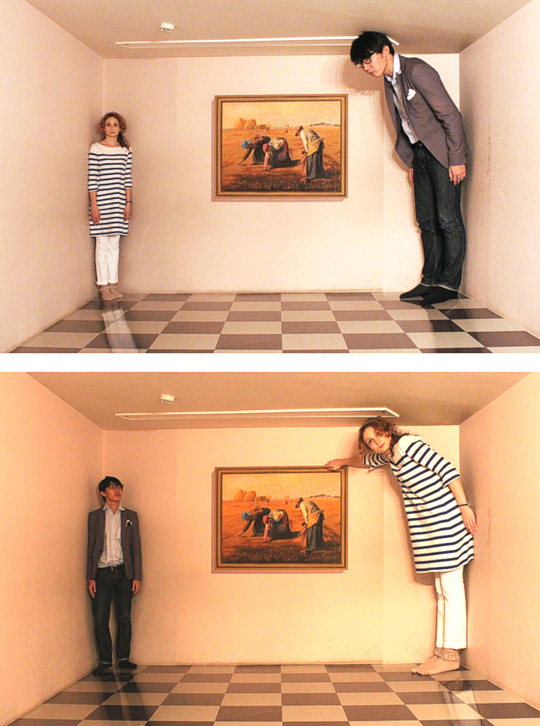

Ames room and the Hering illusion
Thans to Dr. Stevanov and Dr. Wakabayashi
In Japan, the ‘functional’ illusion is distinguished from the ‘not-functional’ illusion. To put it simply, the former is called "damashie" (騙し絵, trompe l'oeil) in Japanese, while the latter is called "sakushi" (錯視, visual illusion in a narrow sense) in Japanese. For example, the Ames room, a kind of trompe l'oeil, can be understood in terms of competition between shape constancy (形の恒常性) and size constancy (大きさの恒常性). Both are functional. On the other hand, the ‘Rotating snakes’ illusion created by Kitaoka in 2003 shows illusory motion in a static image but has not been accounted for in terms of any function. Actually sakushi is translated to visual illusion or optical illusion, but they are not equal.
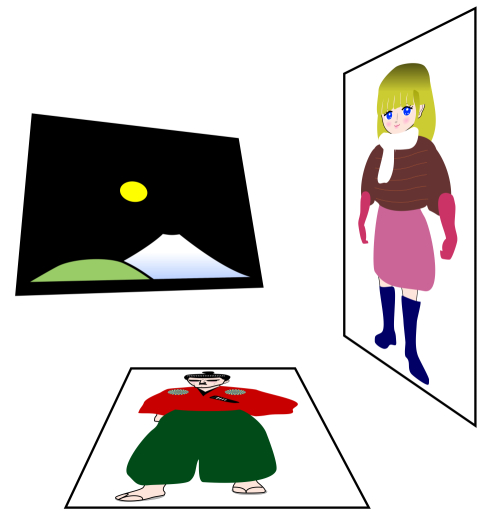
Trapezoids appear to be rectangles which tilt in depth (= shape constancy:
形の恒常性).
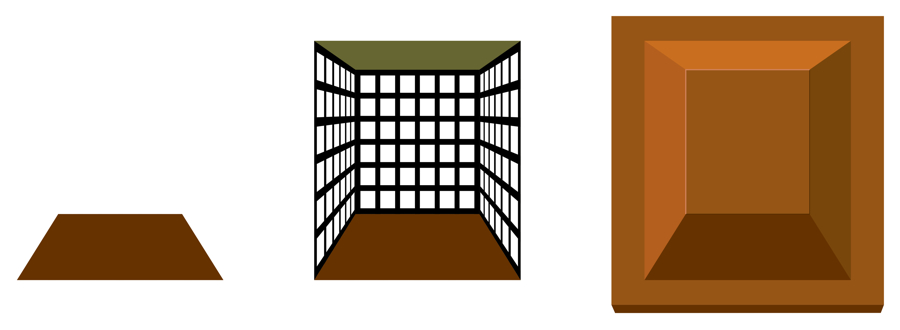
Rectangles appear to be rectangles which are placed in a frontoparallel plane (= shape constancy).
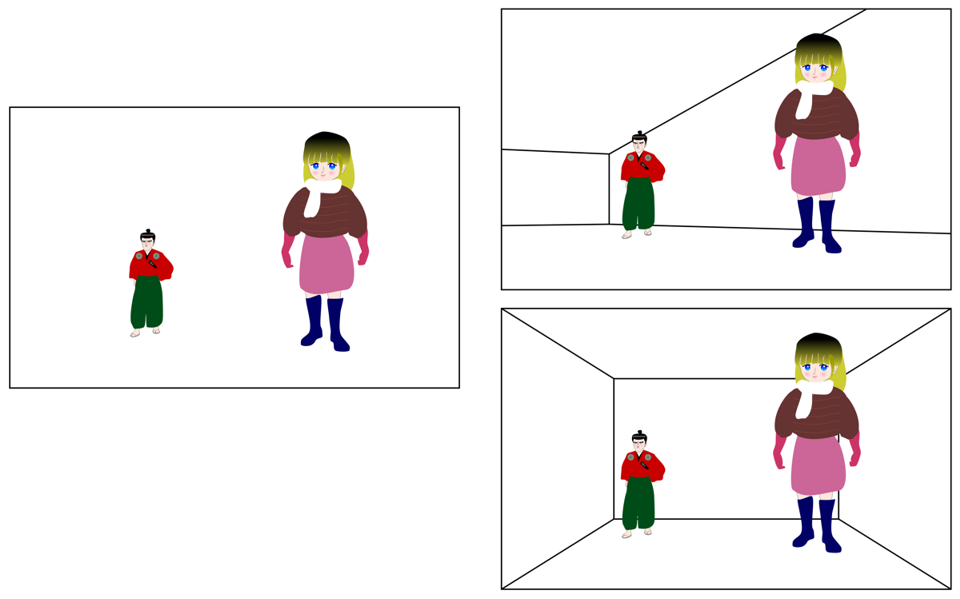
Left: Ambiguous image. Upper-right: The two persons appear to be 'actually the same size' though the retinal
sizes are different (= size constancy). Lower-right: The left person appears to be much smaller than the right one (= Ames
room situation), probably because the rectangle in their back gives information
that the two persons stand at nearly the same distances. That is, the effect
of shape constancy overcomes that of size constancy in this situation.
This (Ames room) is kind of visual illusion, but is not necessarily kind
of sakushi (錯視) in Japanese because sakushi refers to be 'not-functional'
illusions such as motion illusion in a static images as shown below. I
would like to learn how they are categorized in China, Korea, as well as
other Asian countries.
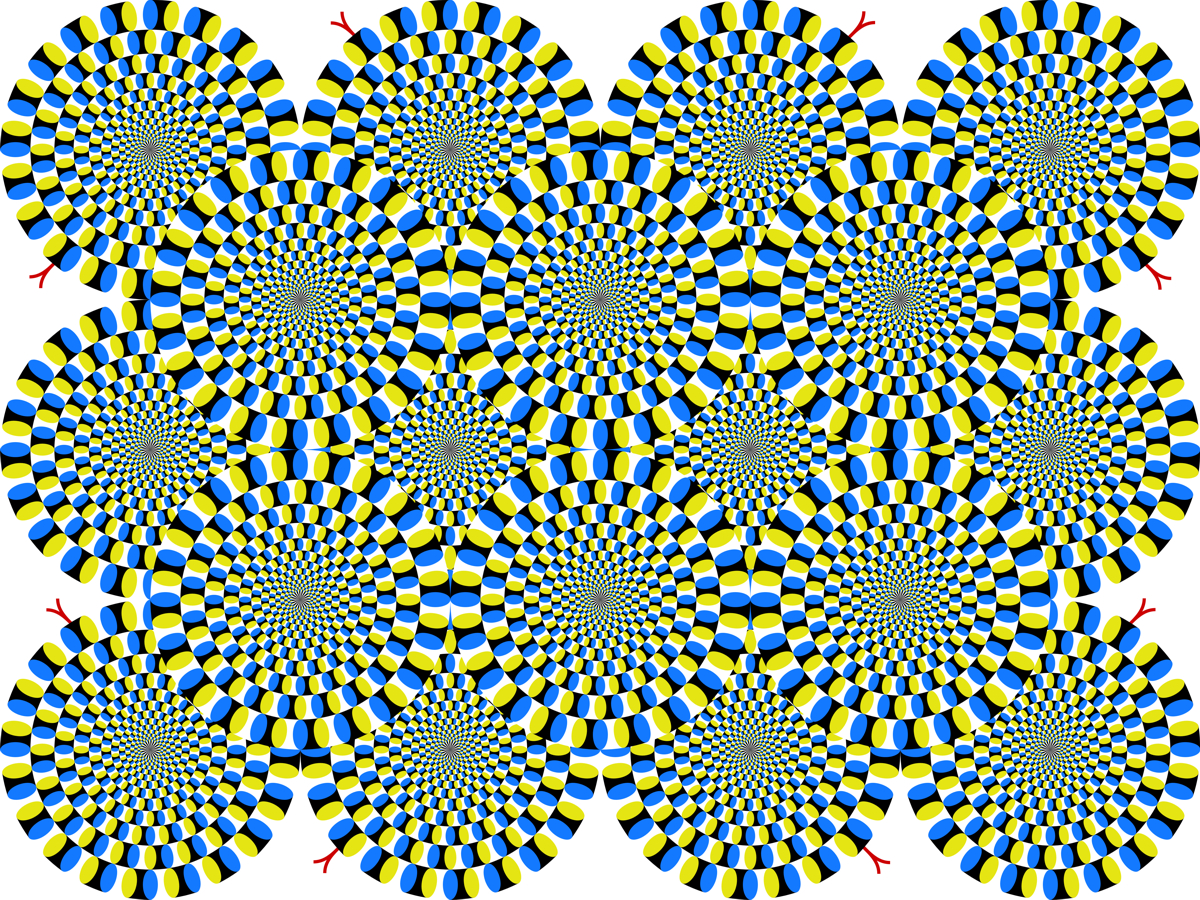
"Rotating snakes"
(a remke)
Copyright Akiyoshi Kitaoka 2013 (February 16)
Yet, there are some illusions which are ambiguous and cannot be perfectly classified into either of the two categories.
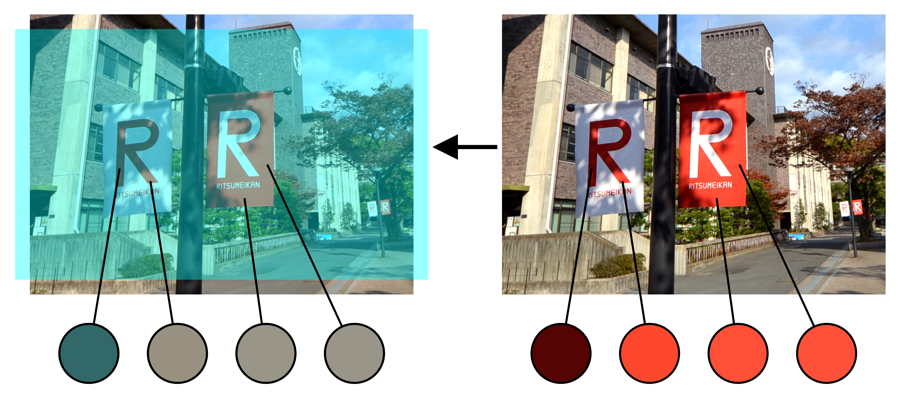
"Ritsumeikan flags"
In the left image, there are no red components but the flag appears to be reddish to some degree.
Copyright Akiyoshi Kitaoka 2012 (November 30)
Demo print DOC

References
北岡明佳 (2011) 色の錯視いろいろ (2)色の恒常性と2つの色フィルタ 日本色彩学会誌, 35(3), 234-236. PDF, PDF (high-resolution)
北岡明佳 (2011) 色の錯視いろいろ (1)「目の色の恒常性」という錯視の絵 日本色彩学会誌, 35(2), 118-119. PDF
Q: Which of the three colors shown below is the same color as the moon?
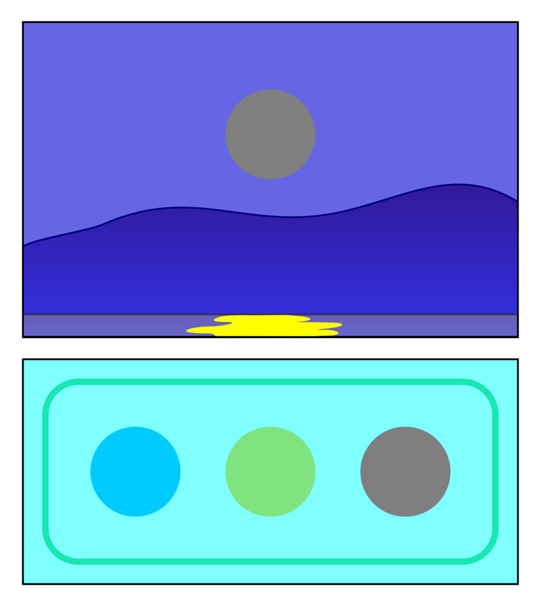

Additive color changes
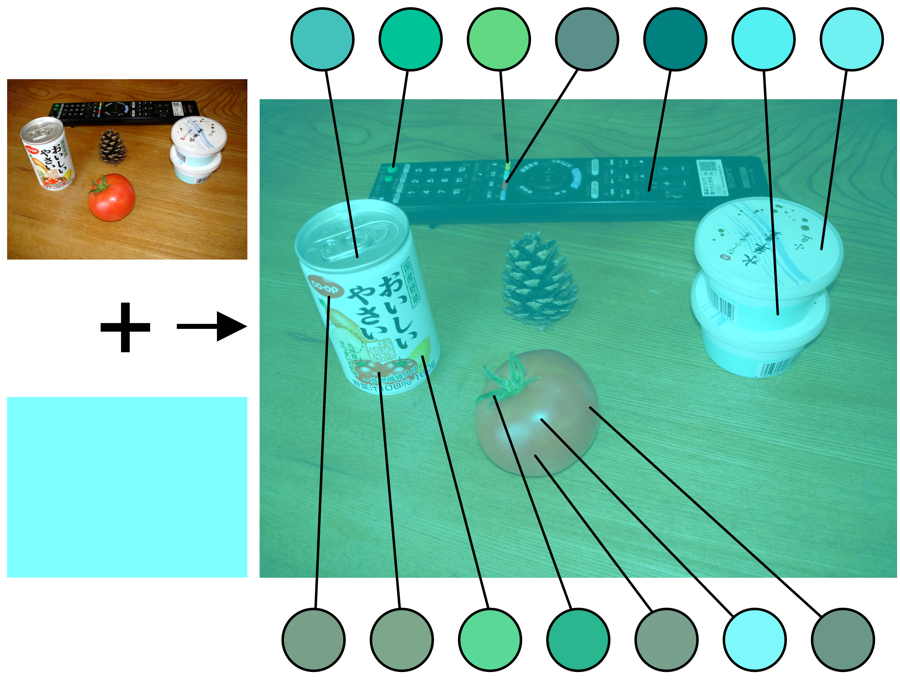
北岡明佳 (2011) 色の錯視いろいろ (2)色の恒常性と2つの色フィルタ 日本色彩学会誌, 35(3), 234-236. <図2>

Multiplicative color change
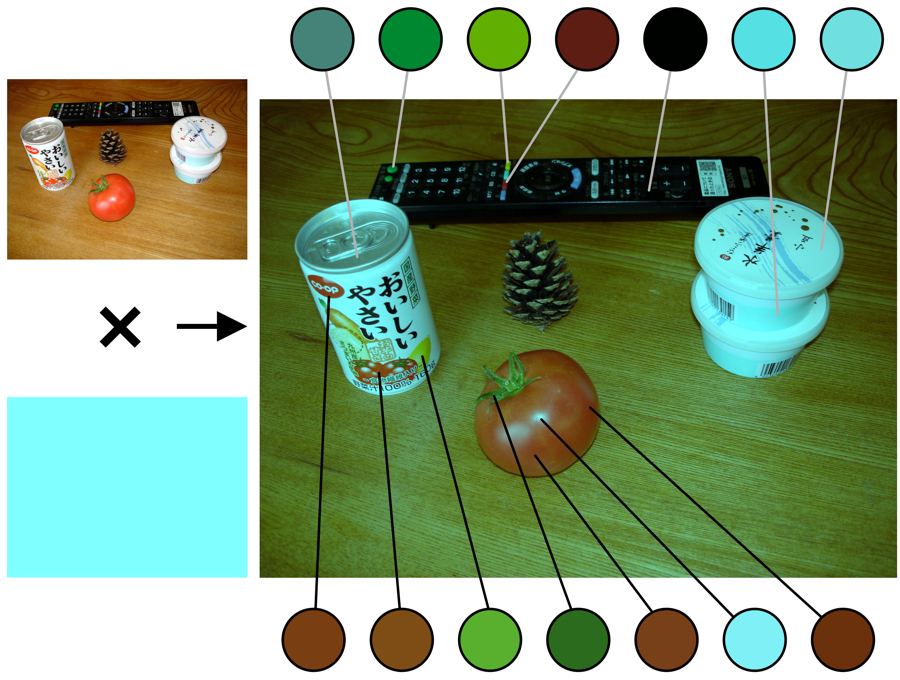
北岡明佳 (2011) 色の錯視いろいろ (2)色の恒常性と2つの色フィルタ 日本色彩学会誌, 35(3), 234-236. <図4>
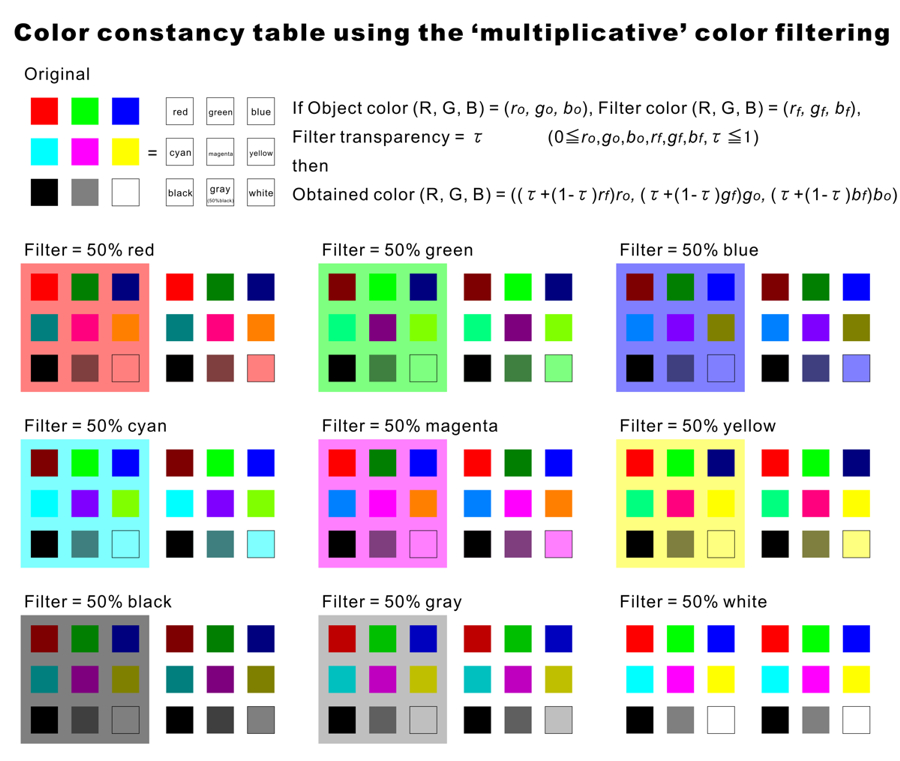
A Color Contrast-Color Constancy Continuum
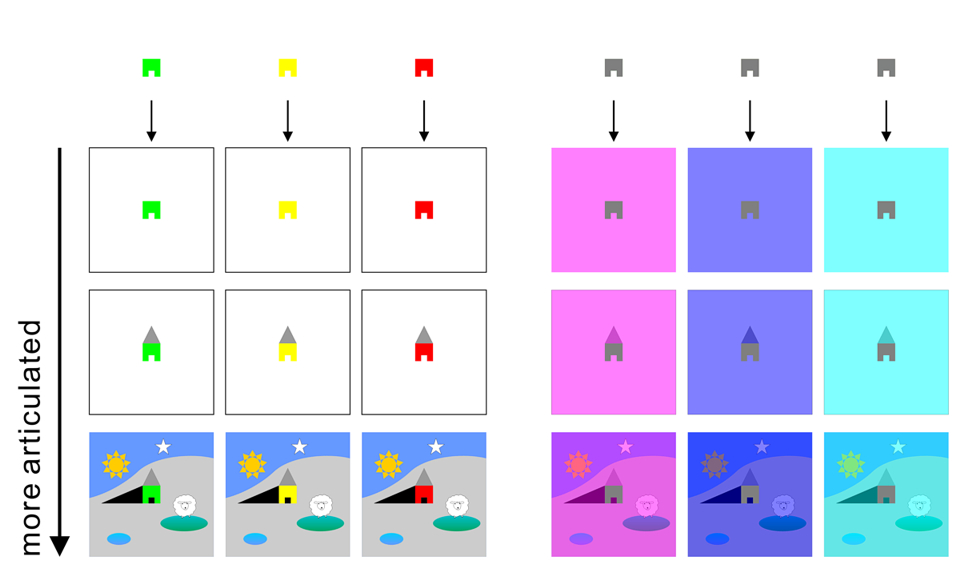
The color contrast effect is continual with the additive type of color constancy. The more articulated the image is, the stronger the color contrast effect, which leads to color constancy.
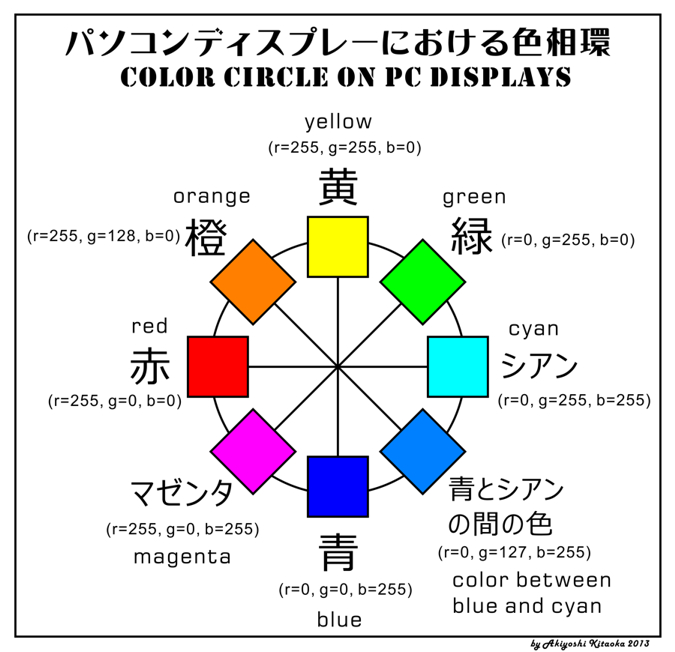
Spiral illusion
The spiral illusion is kind of tilt illusion shown in concentric circles.
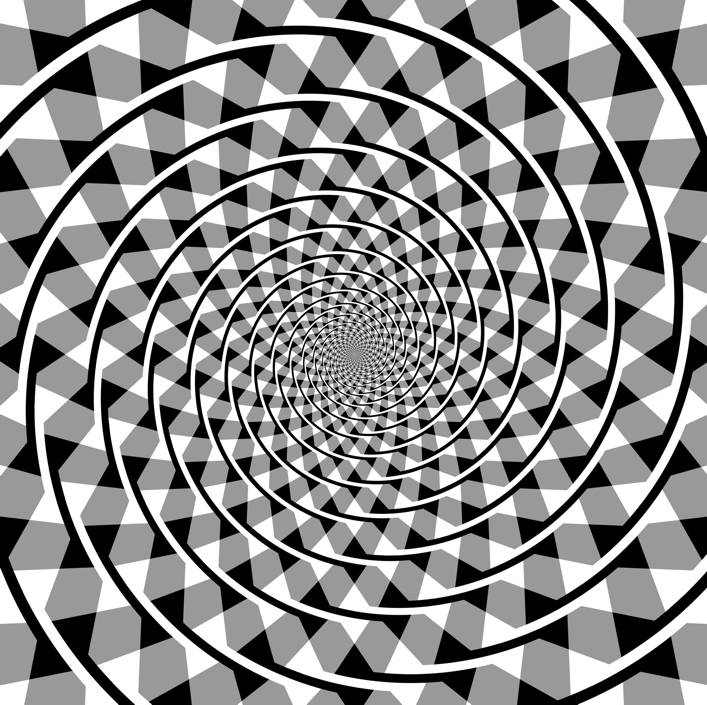
Fraser's spiral
The term "spiral illusion" had long referred to the spiral illusion of the Fraser illusion (Fraser, 1908) before we elucidated that any tilt illusion can form spiral illusion (Kitaoka, Pinna and Brelstaff, 2001). This page shows a copy of Fraser's spiral produced by PC programming. <2003/8/30>
Fraser, J. (1908) A new visual illusion of direction. British Journal of Psychology, 2, 307-320.
Kitaoka, A., Pinna, B., and Brelstaff, G. (2001). New variations of spiral illusions. Perception, 30, 637-646.
Catalogue of spiral illusions
北岡明佳 (2006) 渦巻き錯視のメカニズム じっきょう数学資料, 52, 13-15. PDF
Tilt illusion is a subcategory of geometrical illusion, in which lines or edges appear to tilt clockwise or counterclockwise. (e.g., Zöllner illusion, Fraser illusion, Café Wall illusion)
Spiral illusion can be formed with any tilt illusion.
Spiral illusion of the Fraser illusion
"Spiral blood vessel"
Red concentric rings appear to be a spiral that approaches the center rotating clockwise.
Copyright Akiyoshi Kitaoka 2007 (June 26)
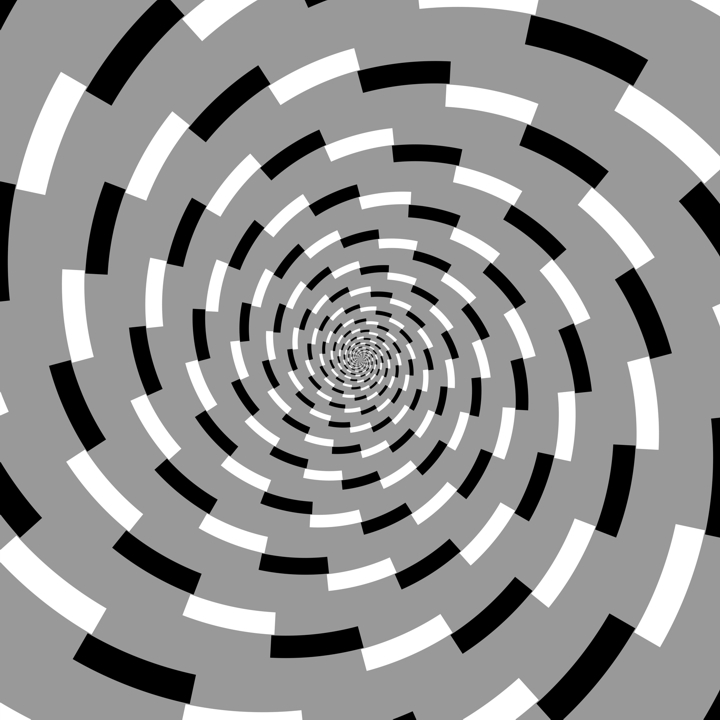
Simple version of the spiral illusion of the Fraser illusion
Concentric rings of black and white line segments appear to be spirals that approach the center rotating counterclockwise.
Spiral illusion of the Café Wall illusion
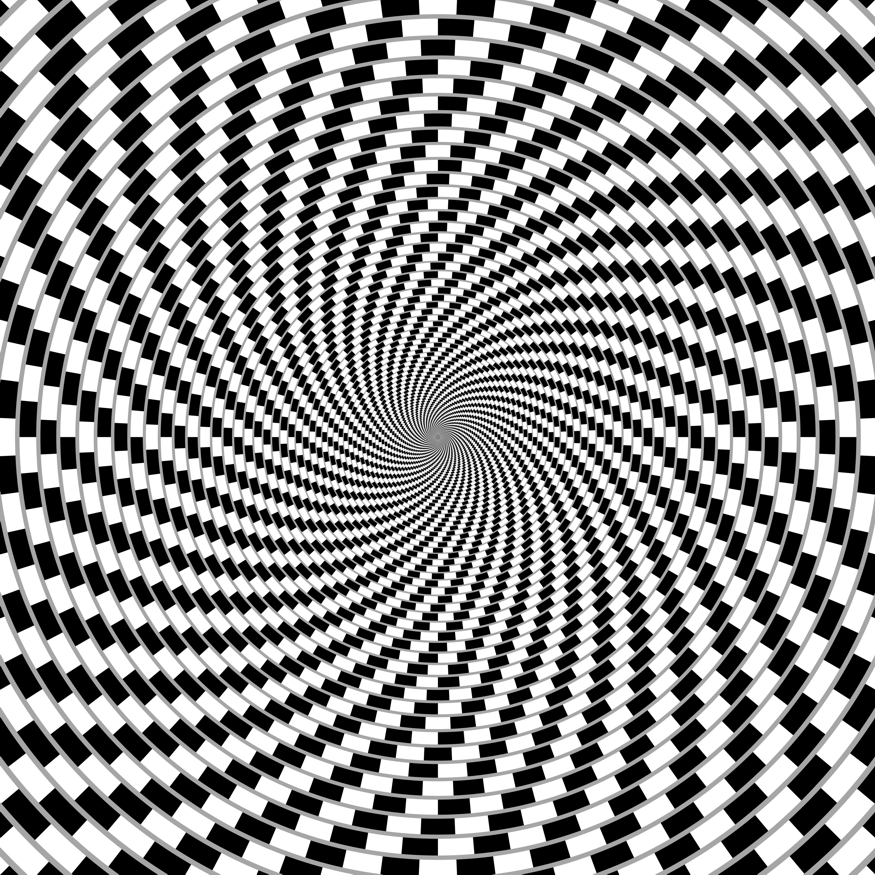
Spiral illusion of the Cafe Wall illusion
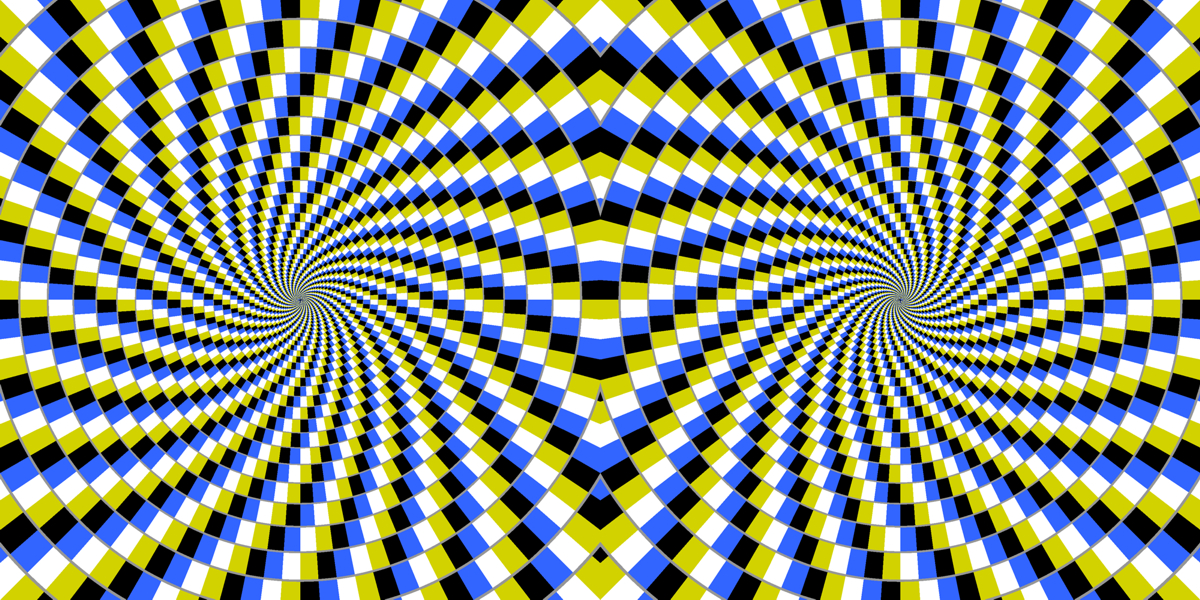
"Rotating spiral illusions"
Concentric circles appear to be spirals.
Copyright Akiyoshi Kitaoka 2010 (October 20
Spiral illusion of the Zöllner illusion
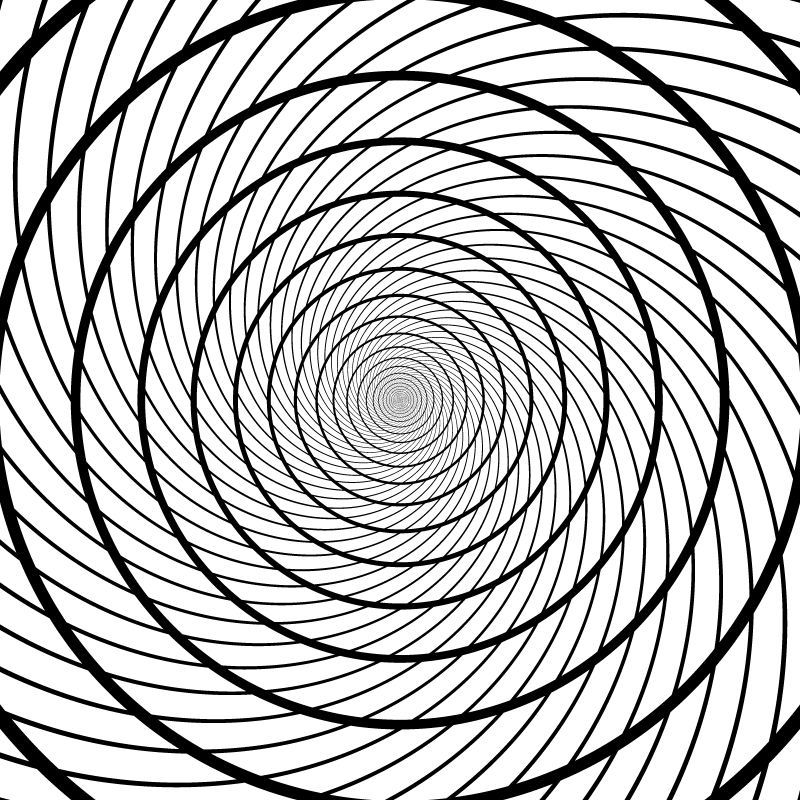
Spiral illusion of the Zöllner illusion
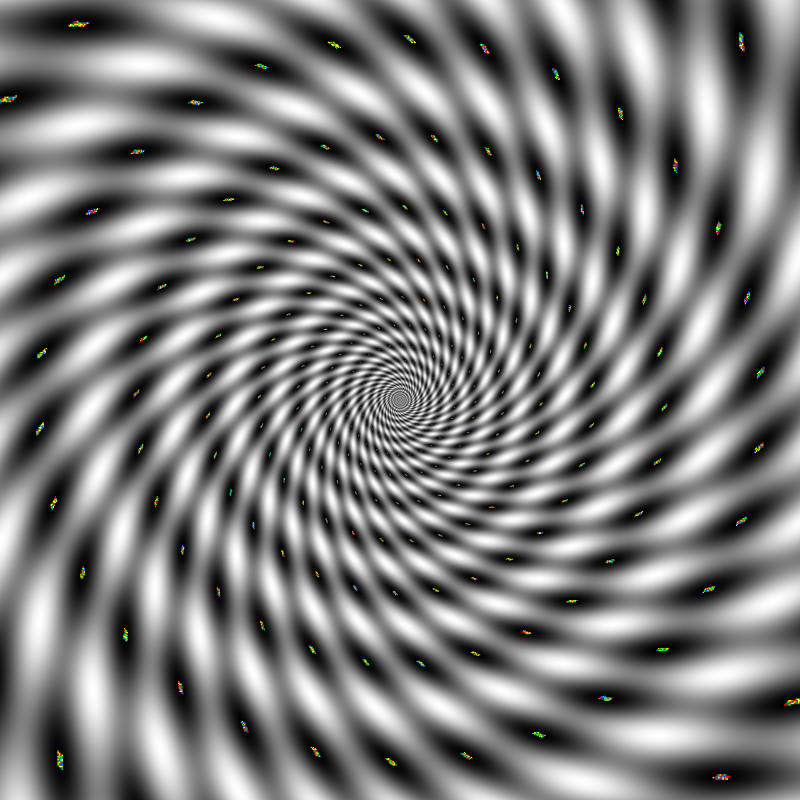
"Spiral warp"
Concentric rings appear to be spirals.
Copyright Akiyoshi Kitaoka 2007 (June 29)
equiangle = 45 deg
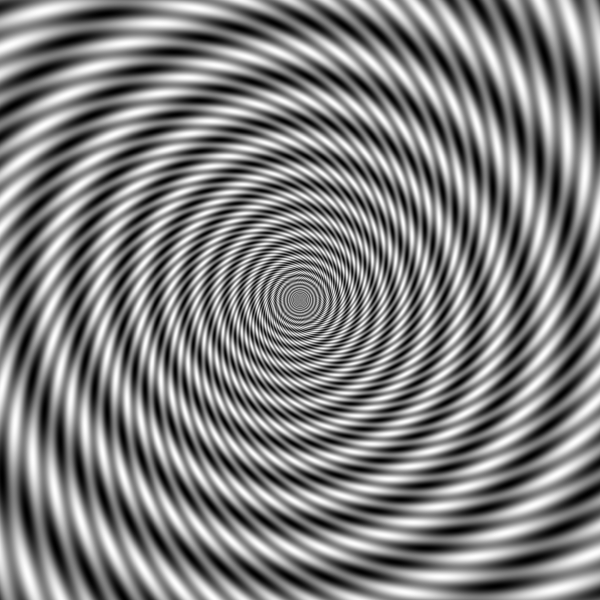
Spiral illusion of the Zöllner illusion
The spiral illusion of the Zöllner illusion:
Kitaoka, A., Pinna, B., and Brelstaff, G. (2001). New variations of spiral illusions. Perception, 30, 637-646.
Spiral illusion of the Popple illusion
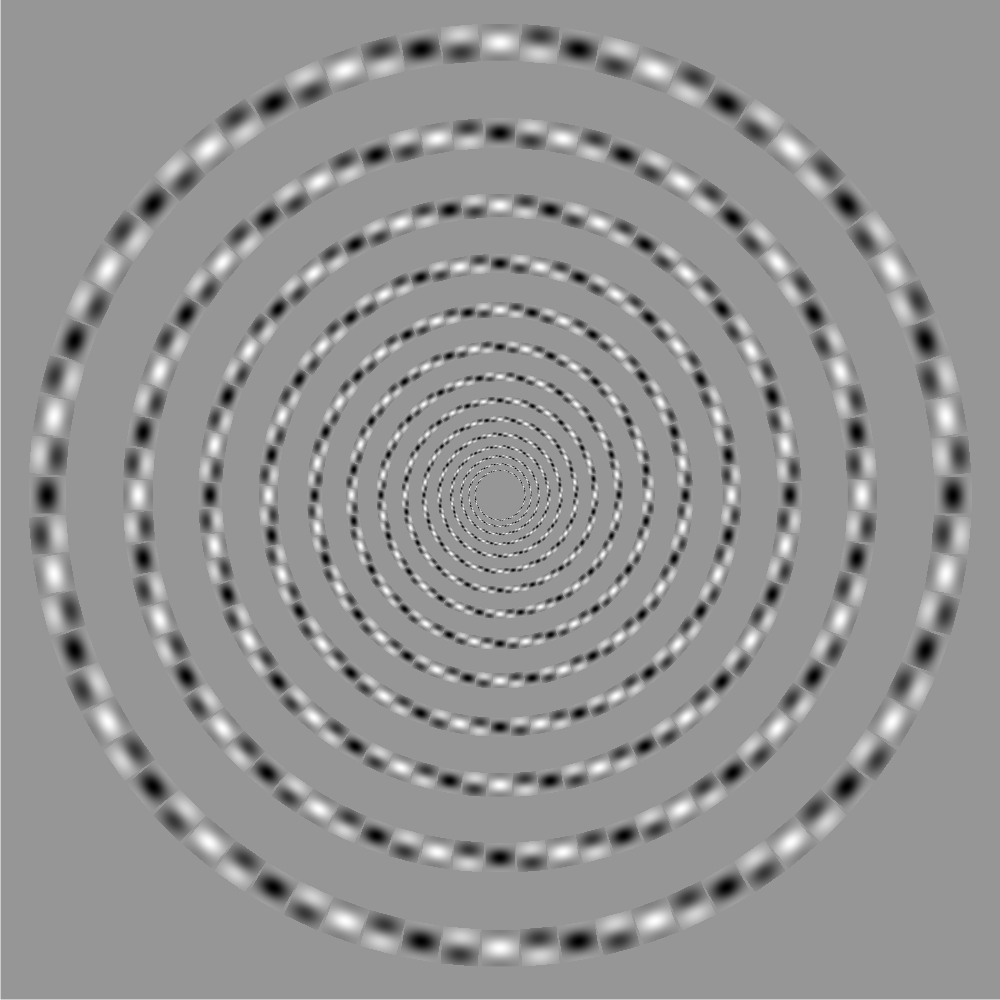
Spiral illusion of the Popple illusion
Copyright Akiyoshi Kitaoka 2007 (August 29)
Spiral illusion of the illusion of fringed edges
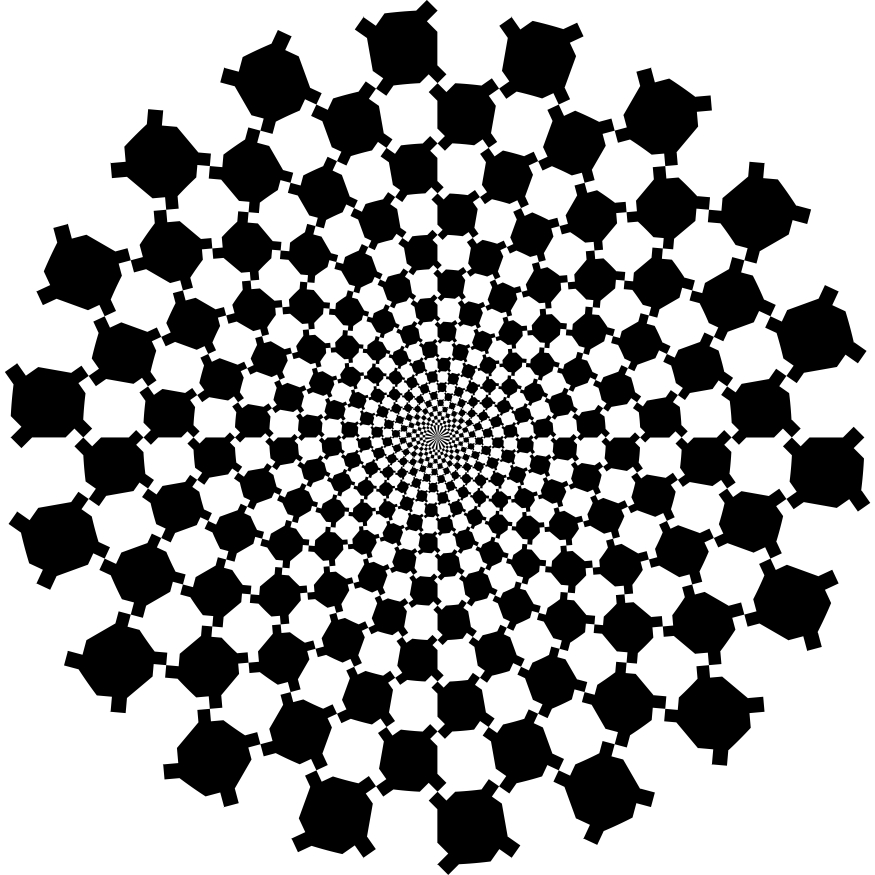
Spiral illusion of the illusion of fringed edges
Spiral illusion of the illusion of Y-junctions
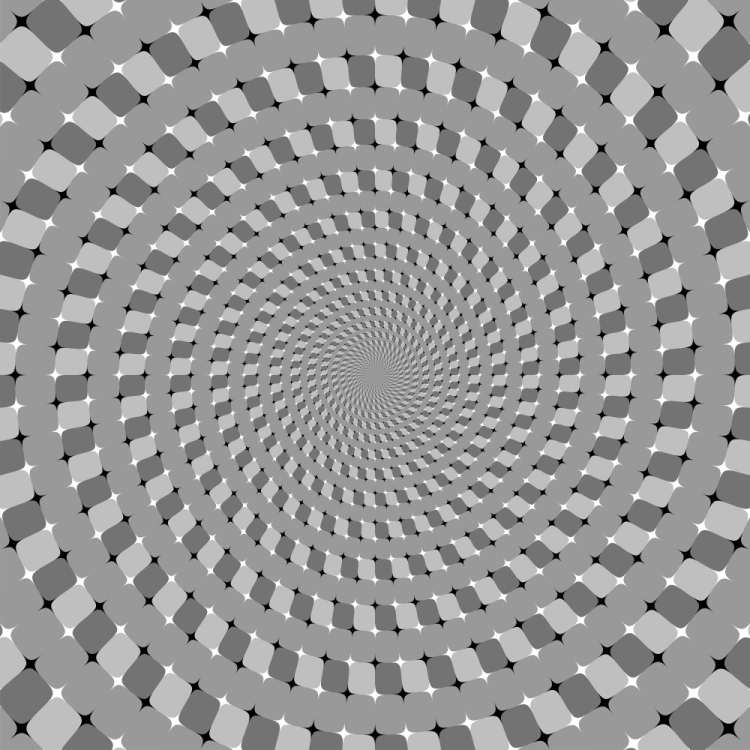
Spiral illusion of the illusion of Y-junctions
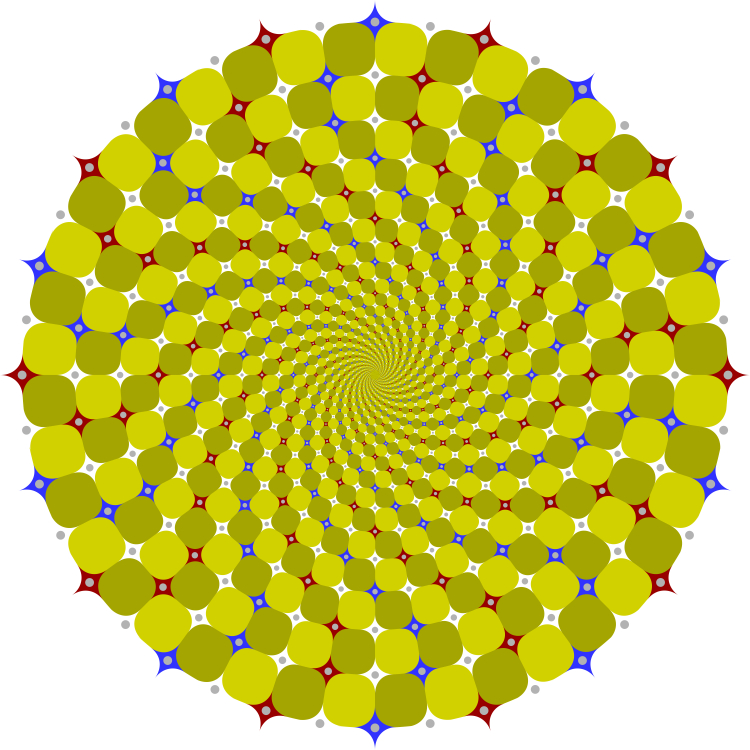
"Neural circuit spirals 2"
Concentric circles appear to be spirals (going to the center by rotating clockwise). Moreover, the inner part appears to rotate clockwise (counterclockwise) when observers approach (move away from) the image keeping their eyes fixed at the center.
Copyright Akiyoshi Kitaoka 2007 (August 7)
Spiral illusion of the fractal tilt illusion
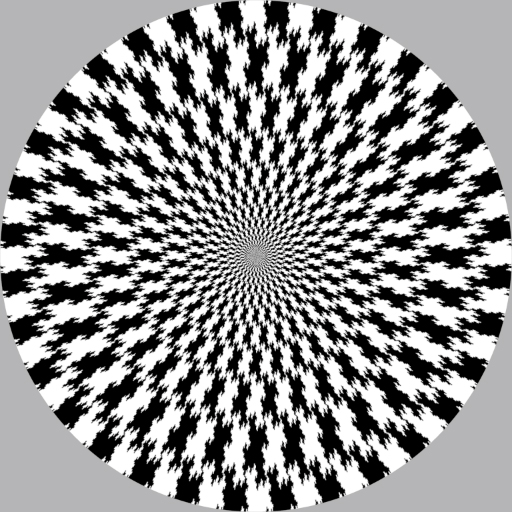
"Fractal spiral illusion"
Concentric rings made up of fractal islands appear to form spirals.
Copyright Hitoshi & Shinobu Arai
2007
from Professor Hitoshi Arai,
Graduate School of Mathematical Sciences, University of Tokyo, October 4,
2007
The first illusion image made up of fractals!
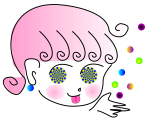 Suggested function
Suggested function
Kitaoka, A., Pinna, B., and Brelstaff, G.
(2001). New variations of spiral illusions. Perception, 30,
637-646.
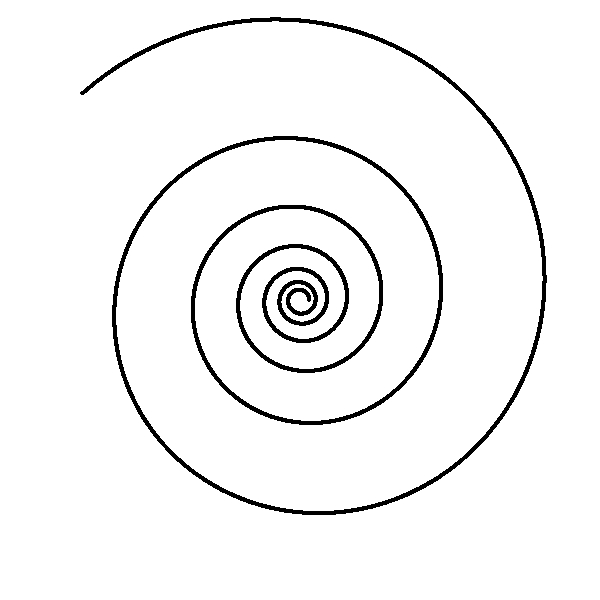
Bernoulli's spiral
r = a exp (k θ)
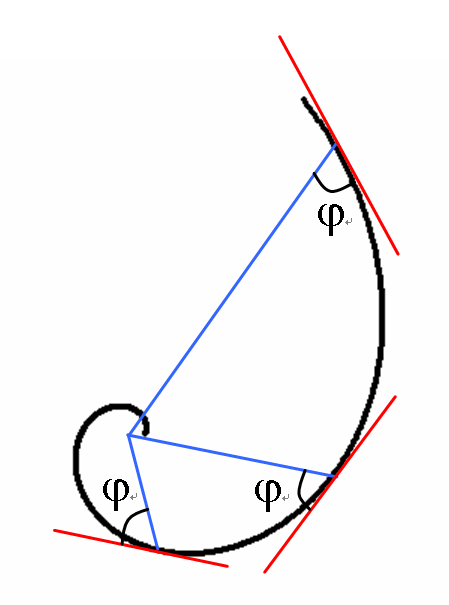
= equiangular spiral
k = 1 / tan (φ)
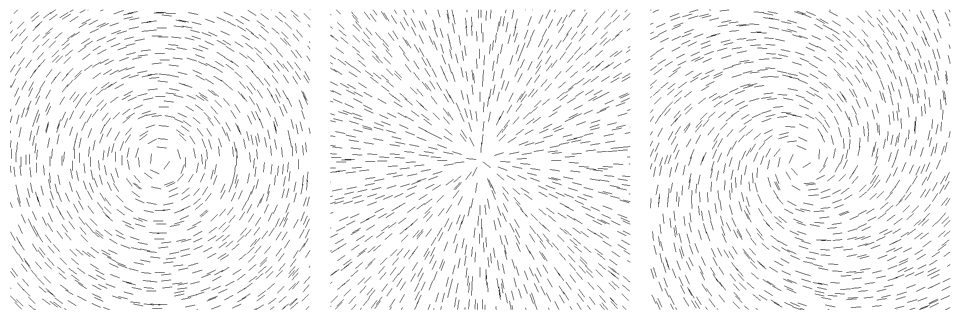
Concentric (φ = 90º), radial (φ = 0º), and spiral (0º < φ < 90º)
Kitaoka, A., Pinna, B., and Brelstaff, G. (2001). New variations of spiral illusions. Perception, 30, 637-646.
Model:
1. Orientation-selective neurons in V1 detect the orientation of the line
or edge in each local area.
2. Polar-coordinates neurons in V4 collect information from the V1 cells
and judge φ.
3. If φ = 90º, the pattern is regarded as Concentric. If φ = 0º,
the pattern is regarded as Radial. If 0º < φ < 90º, the
pattern is regarded as Spiral.
4. In spiral illusion images, V1 cells should output φ = 90º but send
false information of orientation (0º < φ < 90º ) due to
tilt illusion.
5. Then, V4 neurons misjudge it and report "it is a spiral pattern"!
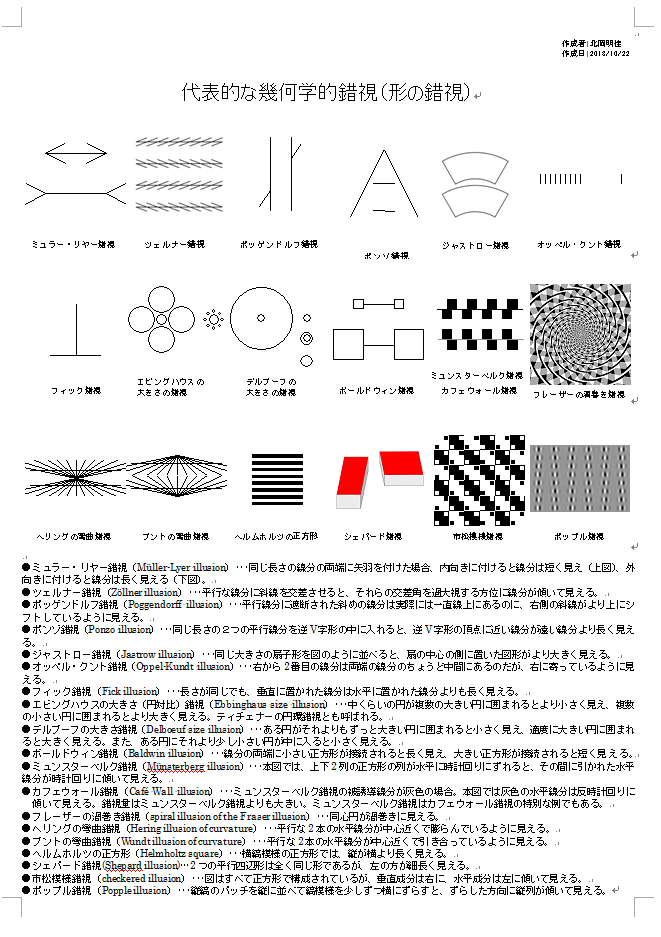
幾何学的錯視の一覧(Geometrical illusions)
Anomalous motion illusion refers to motion illusion in a stationary image, in which part of the
stationary image appears to move. (e.g., Ouchi illusion, Enigma illusion,
optimized Fraser-Wilcox illusion)
Visual delay-dependent motion illusion
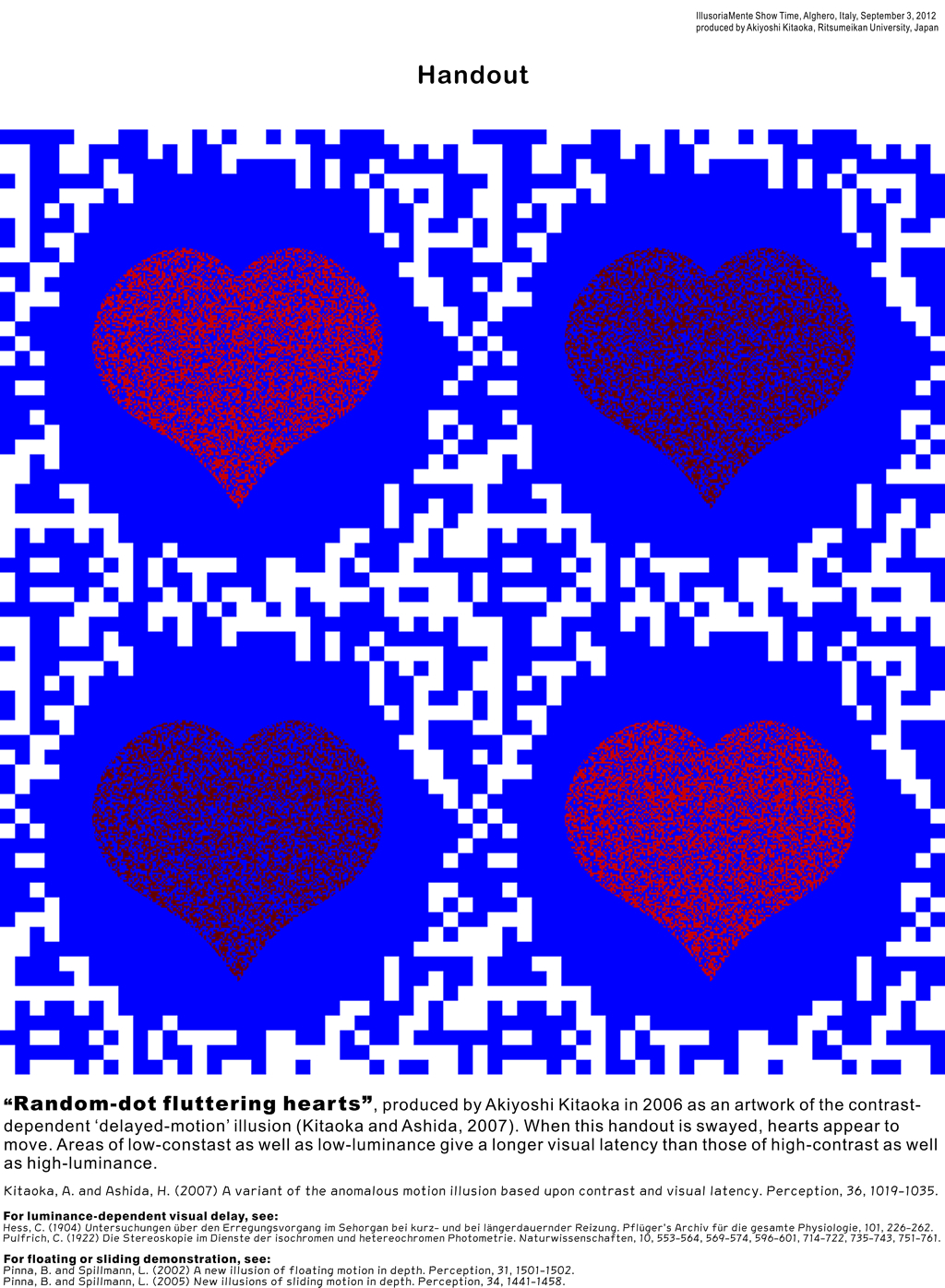
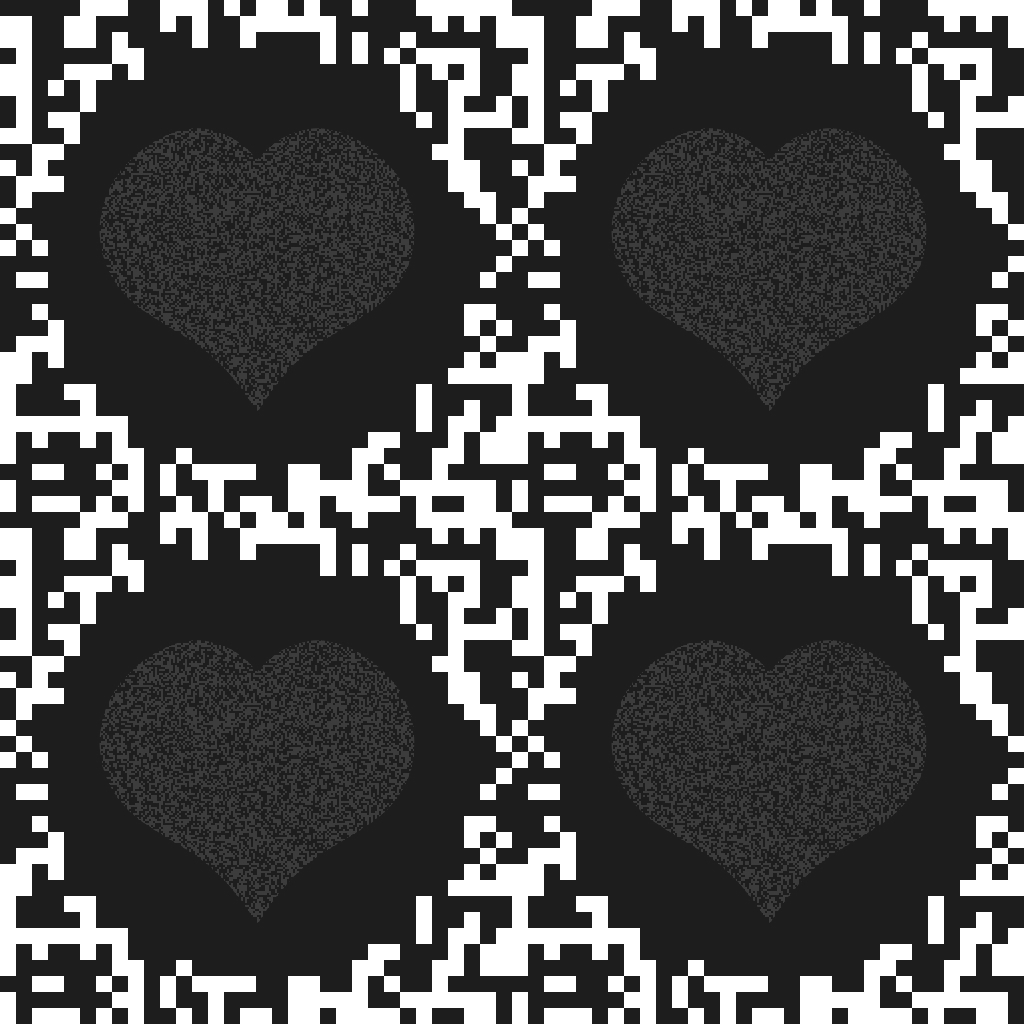
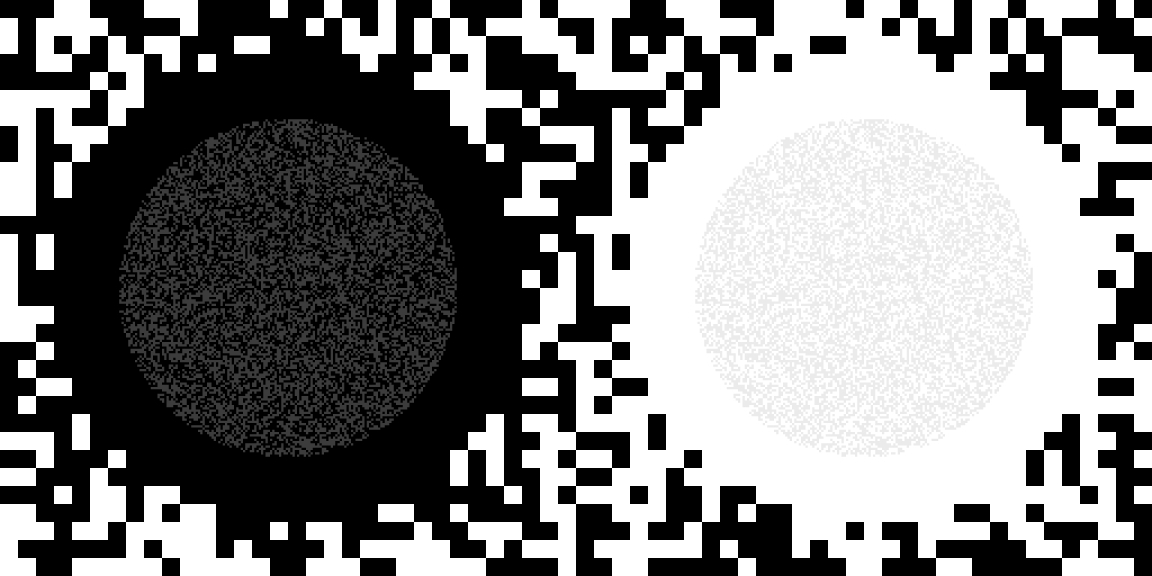
1. High-luminance parts show shorter latency than low-luminance part.
2. High-contrast parts show shorter latency than low-contrast part. <our finding!>
Kitaoka, A. and Ashida, H. (2007) A variant of the anomalous motion illusion based upon contrast and visual latency. Perception, 36, 1019-1035. PDF
cf. fluttering-heart illusion

(Helmholtz, 1867; Nguyen-Tri and Faubert 2003; von Grünau 1975a, 1975b, 1976; von Kries 1896)
References
Helmholtz, H. von (1856, 1860, 1866,
1867) Handbuch der Physiologischen Optik. Leipzig: Voss. Part I (1856),
Part II (1860), Part III (1866). The first two parts were published in
the same volume as the third part in 1866. This was called the first
edition according to Robinson (1972). In many case, “1867” is preferred
for citation as follows. Helmholtz, H. von. (1867). Handbuch der
physiologischen Optik. Leipzig: Voss. Translated by J P C Southall of
the third German edition (1909-1911) was published as Treatise on
Physiological Optics, New York: Dover (1924-1925, 1962). Edited by N.
Wade, Helmholtz's Treatise on Physiological Optics, Bristol: Thoemmes
(2000). The following information was taken from Wade (2004).
Helmholtz H, 1867 "Handbuch der physiologischen Optik", in Allgemeine
Encyklopädie der Physik volume 9, Ed. G Karsten (Leipzig: Voss)
Helmholtz H, 1896 Handbuch der physiologischen Optik 2nd edition (Hamburg: Voss)
Helmholtz H, 1909 Handbuch der physiologischen Optik volume 1, 3rd
edition, Eds A Gullstrand, J von Kries, W Nagel (Hamburg: Voss)
Helmholtz H, 1910 Handbuch der physiologischen Optik volume 3, 3rd
edition, Eds A Gullstrand, J von Kries, W Nagel (Hamburg: Voss)
Helmholtz H, 1911 Handbuch der physiologischen Optik volume 2, 3rd
edition, Eds A Gullstrand, J von Kries, W Nagel (Hamburg: Voss)
Helmholtz H, 1924 Helmholtz's Treatise on Physiological Optics volume 1,
translated by J P C Southall (New York: Optical Society of America)
Helmholtz H, 1925 Helmholtz's Treatise on Physiological Optics volume 2,
translated by J P C Southall (New York: Optical Society of America)
Helmholtz H, 1925 Helmholtz's Treatise on Physiological Optics volume 3,
translated by J P C Southall (New York: Optical Society of America)
Helmholtz H, 2000 Helmholtz's Treatise on Physiological Optics (3 volumes) translated by J P C Southall (Bristol: Thoemmes)
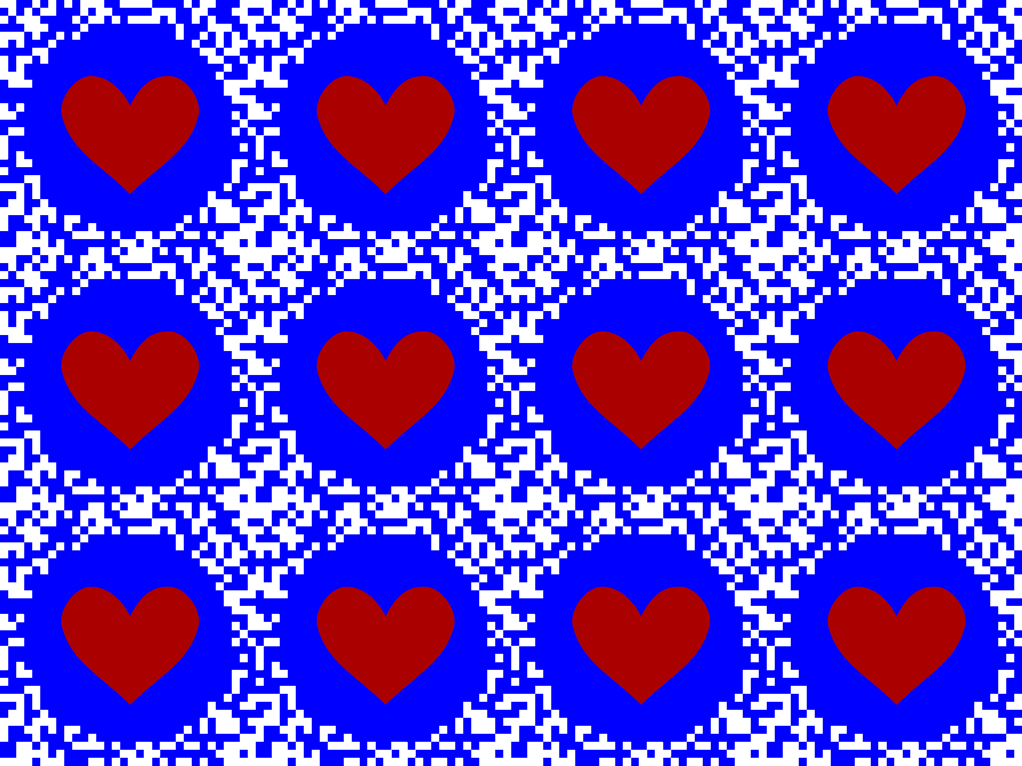
"Fluttering red hearts in front of the blue background 3"
Hearts appear to move when the image is moved or your pair of glasses are moved. This illusion is enhanced in a dark condition or in the mesopic vision.
Copyright Akiyoshi Kitaoka 2013 (February 15)
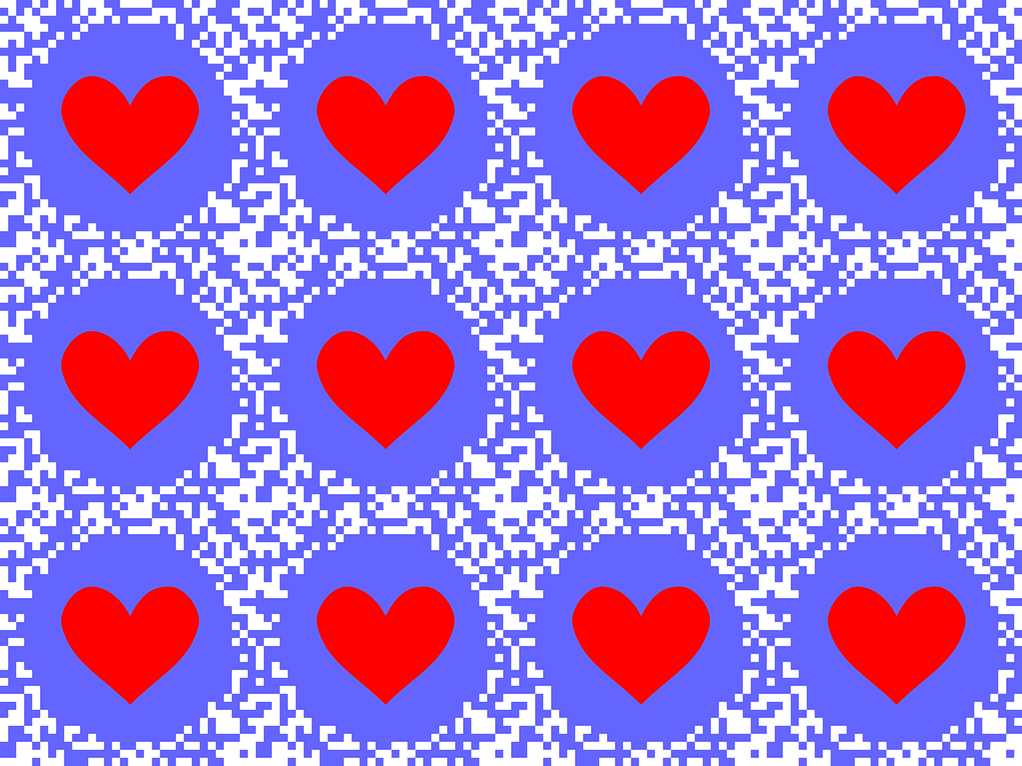
"Fluttering red hearts in front of the blue background"
Hearts appear to move when the image is moved or your pair of glasses are moved. This illusion is enhanced in a dark condition or in the mesopic vision.
Copyright Akiyoshi Kitaoka 2013 (January 18)
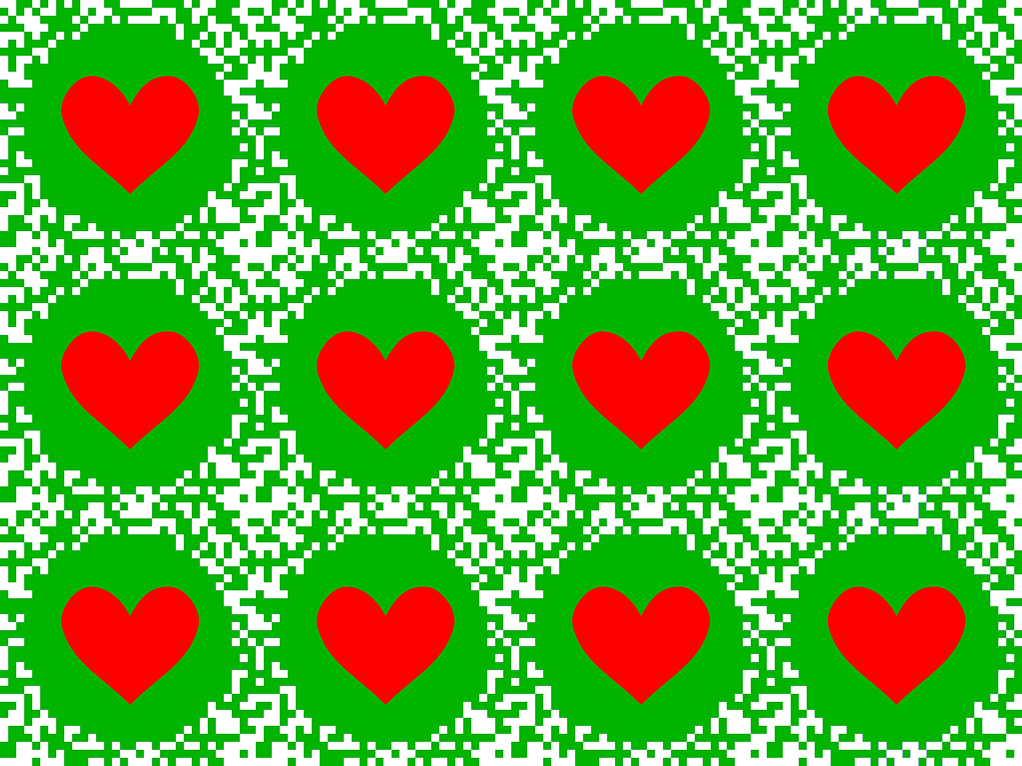
"Fluttering red hearts in front of the green background"
Hearts appear to move when the image is moved or your pair of glasses are moved. This illusion is enhanced in a dark condition or in the mesopic vision.
Copyright Akiyoshi Kitaoka 2013 (January 21)
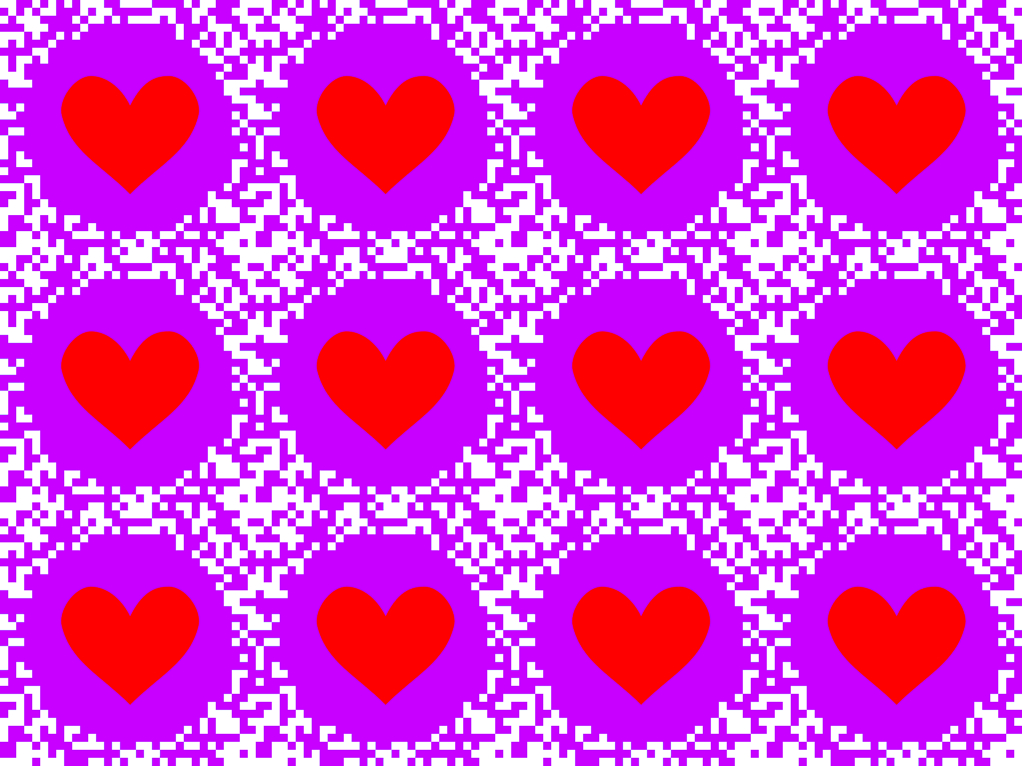
"Fluttering red hearts in front of the red-purple background"
Hearts appear to move when the image is moved or your pair of glasses are moved. This illusion is enhanced in a dark condition or in the mesopic vision.
Copyright Akiyoshi Kitaoka 2013 (January 16)
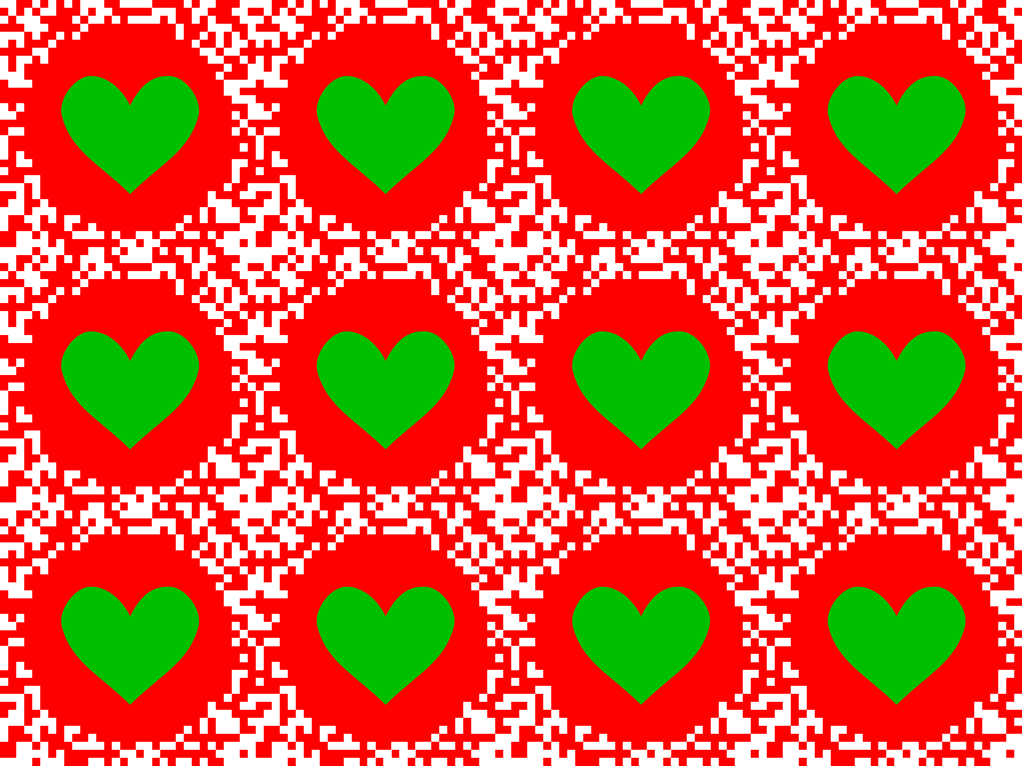
"Fluttering green hearts in front of the red background"
Hearts appear to move when the image is moved or your pair of glasses are moved. This illusion is enhanced in a dark condition or in the mesopic vision.
Copyright Akiyoshi Kitaoka 2013 (February 15)
Fraser-Wilcox illusion group

「蛇の回転」
"Rotating snakes"
Copyright Akiyoshi Kitaoka 2013 (February 16)
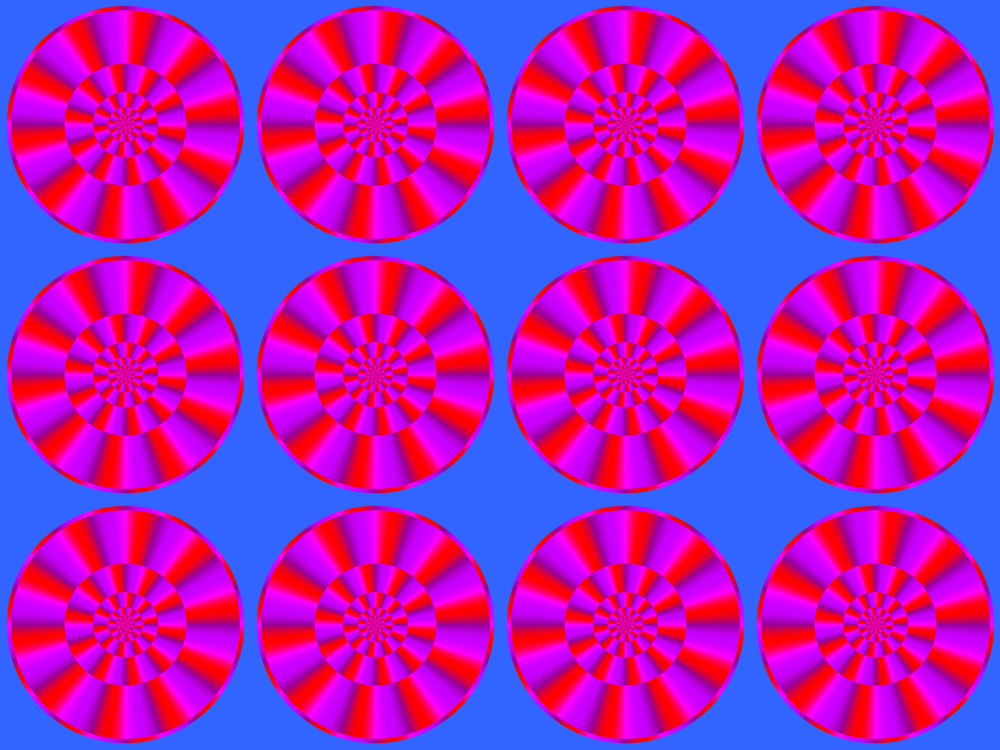
"Rotating red
disks"
Each disk appears to rotate clockwise when this image is presented on a bright PC display or on a print with a bright environment.
Each disk appears to rotate conterclockwise when this image is presented on a dark PC display or on a print with a dark environment.
Copyright Akiyoshi Kitaoka 2013 (January 17)
Conclusion in advance
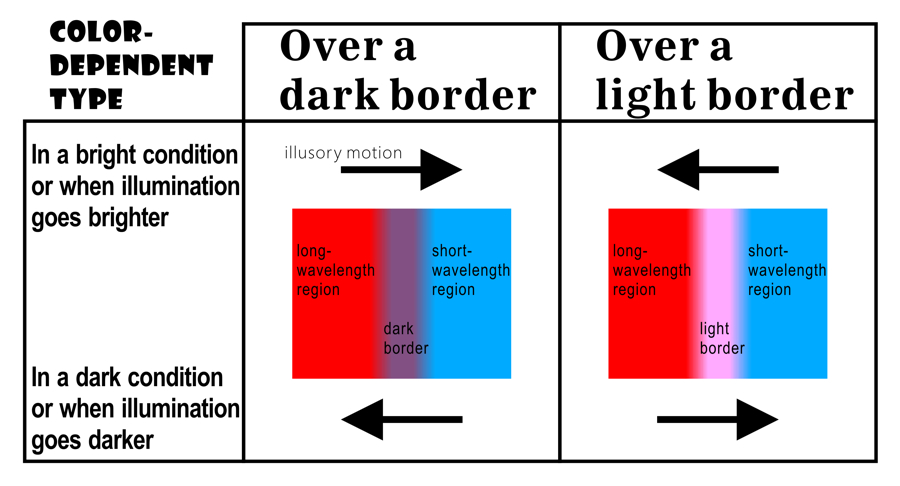
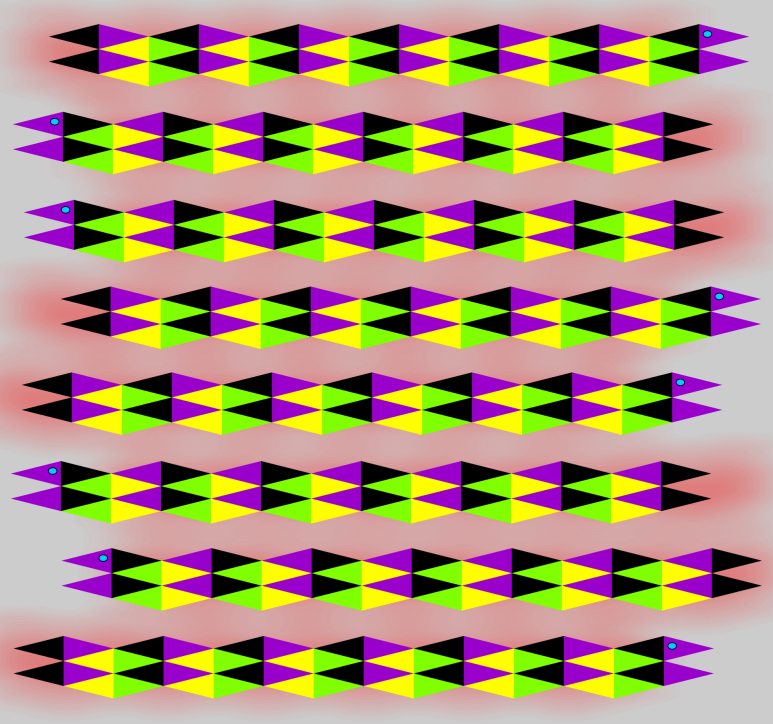
"Moving snakes with a cloud of dust"
Snakes appear to move horizontally.
Copyright Akiyoshi Kitaoka 2009 (June 7)
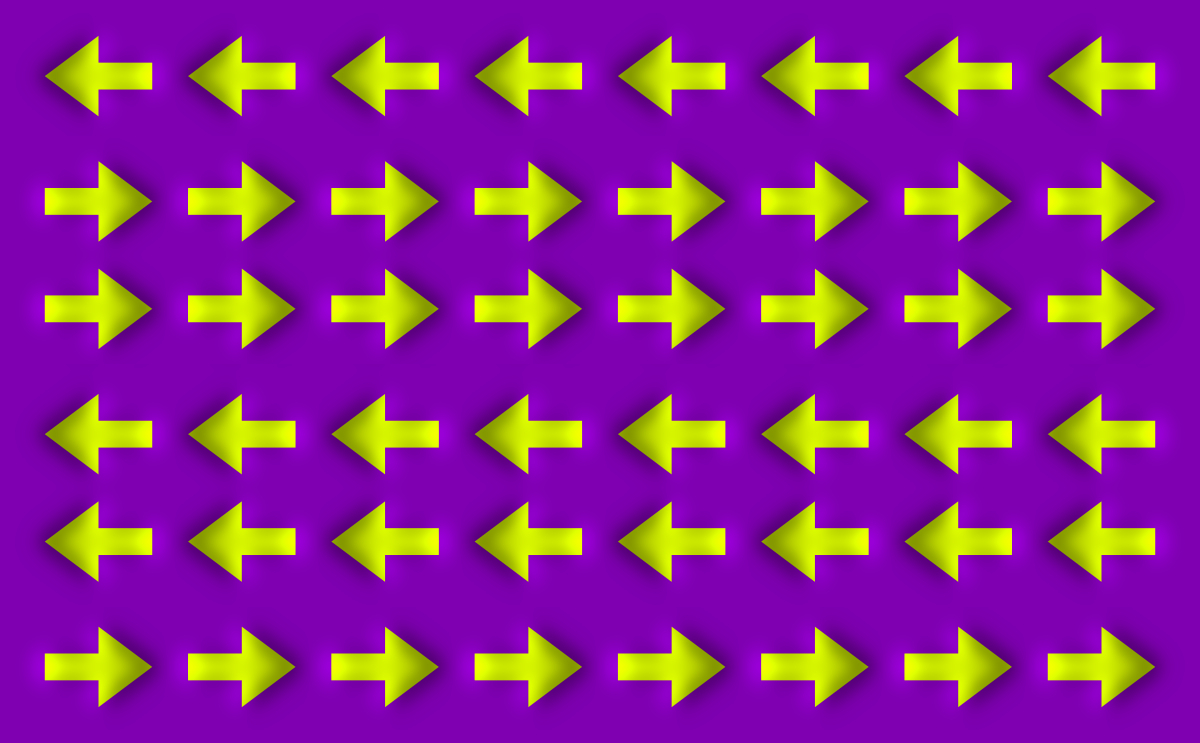
"Moving arrows illusion"
Arrows appear to move.
Copyright Akiyoshi Kitaoka 2013 (September 26)
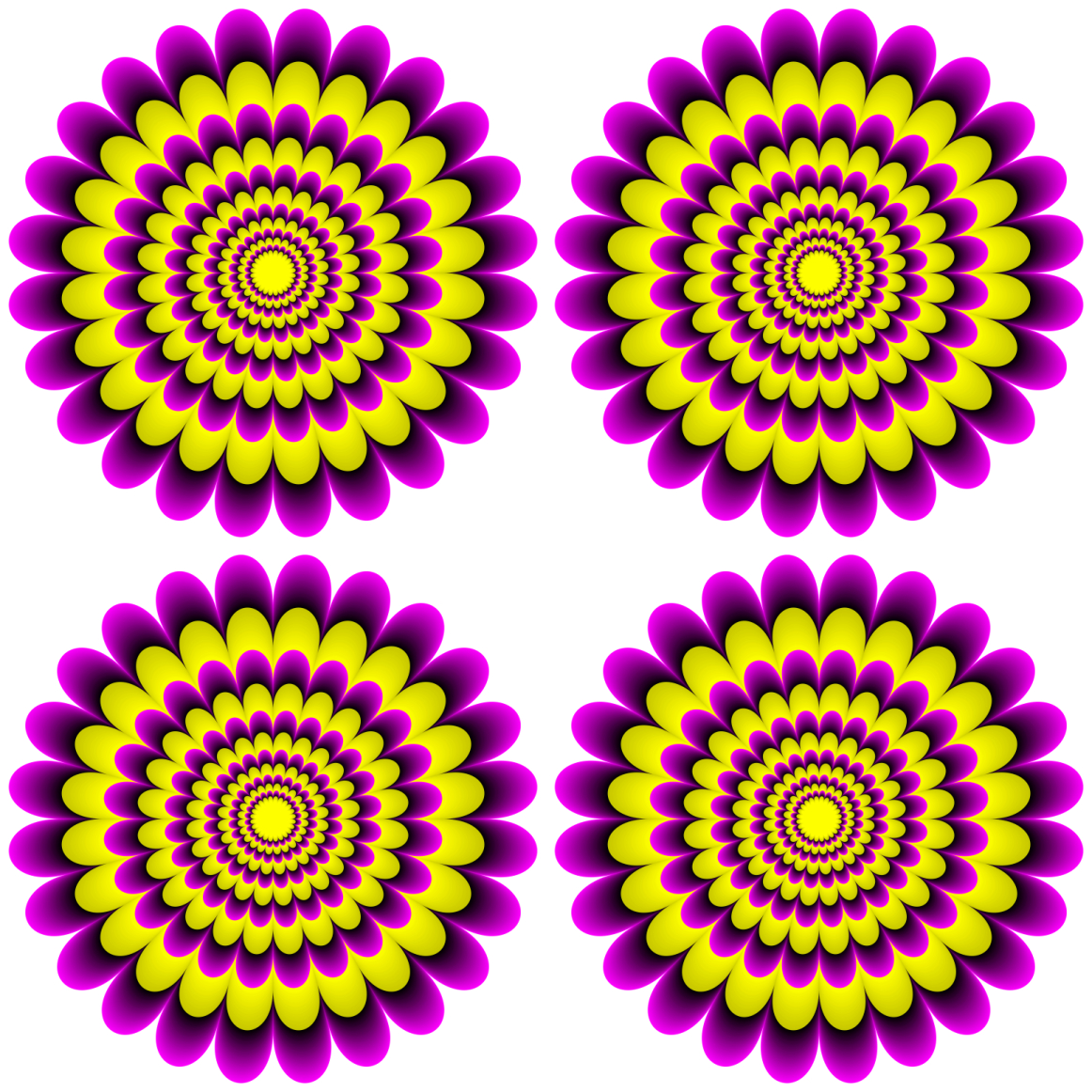
"Blooming flowers"
Flowers appear to expand.
Copyright Akiyoshi Kitaoka 2008 (March 11)
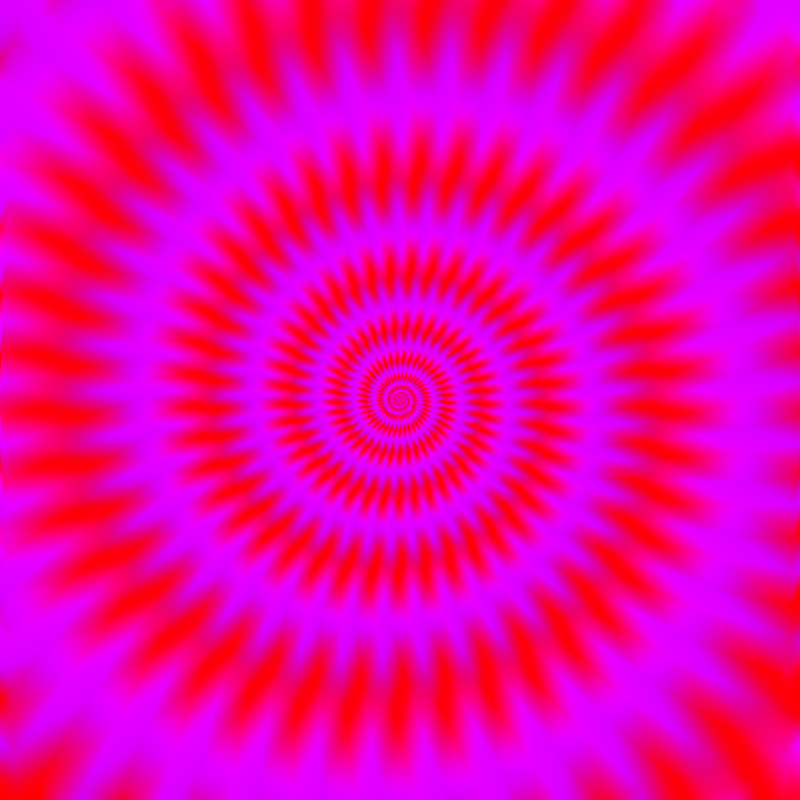
「ぐいぐい昇竜」
Ascending dragon
竜が昇っていくように見える(下から見たところ)。
An dragon appears to rise.
Copyright Akiyoshi Kitaoka 2011 (February 12)
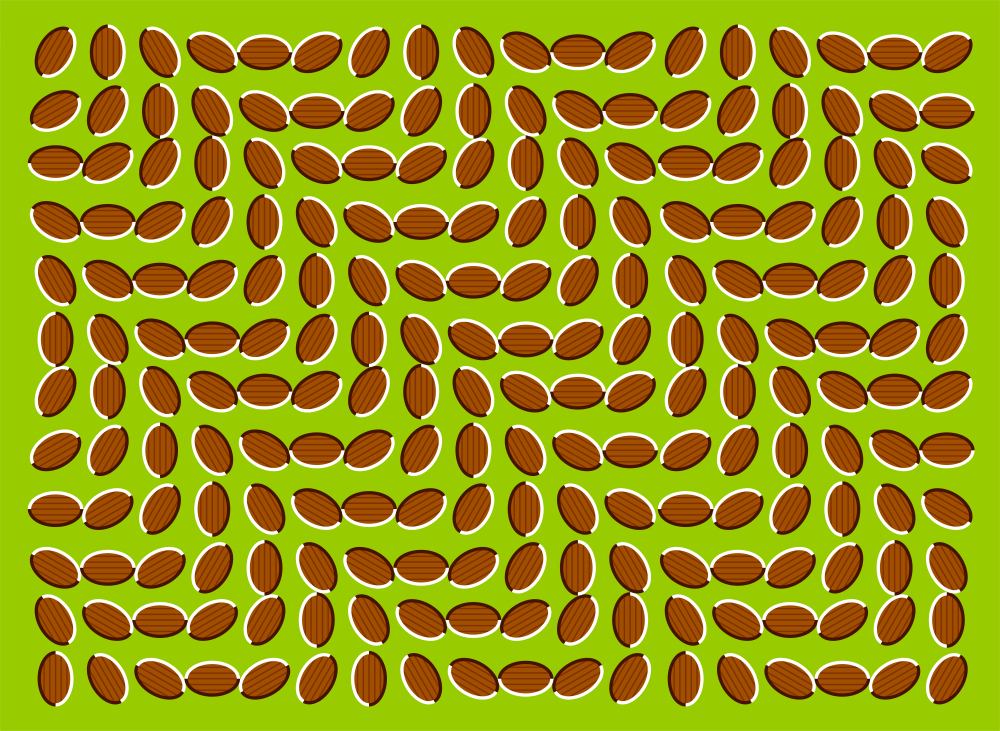
"Dongurakokko" (The donguri wave)
Donguri (acorns) appear to wave.
Copyright A.Kitaoka 2004 (April 19)
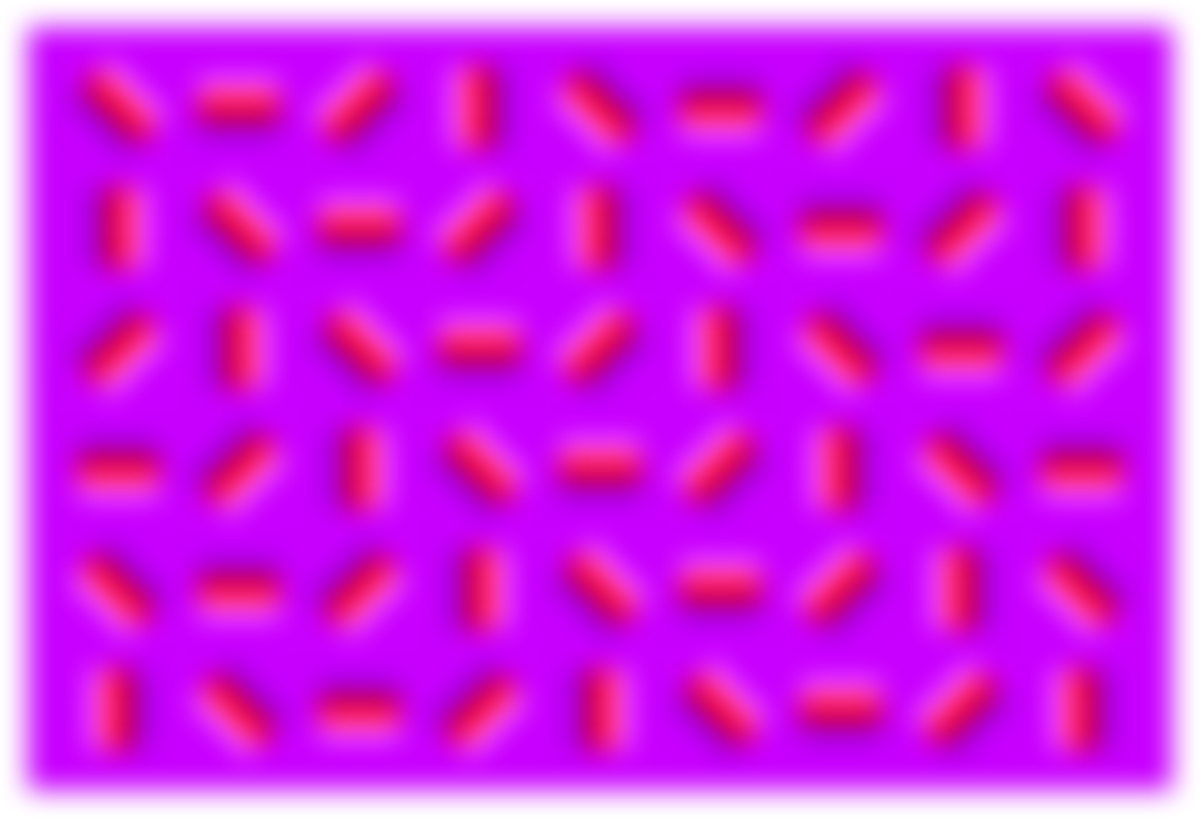
「トロの波」
図が波打って見える。
Copyright Akiyoshi Kitaoka 2011 (September 5)
A brief history of phenomenal aspects of the Fraser-Wilcox illusion group
<Kitaoka, A. (forthcoming). The Fraser-Wilcox illusion and its extension. In Shapiro, A. and Todorovic, D. (Eds.), Oxford Compendium of Visual Illusions. Oxford University Press.>
1. Fraser and Wilcox (1979)
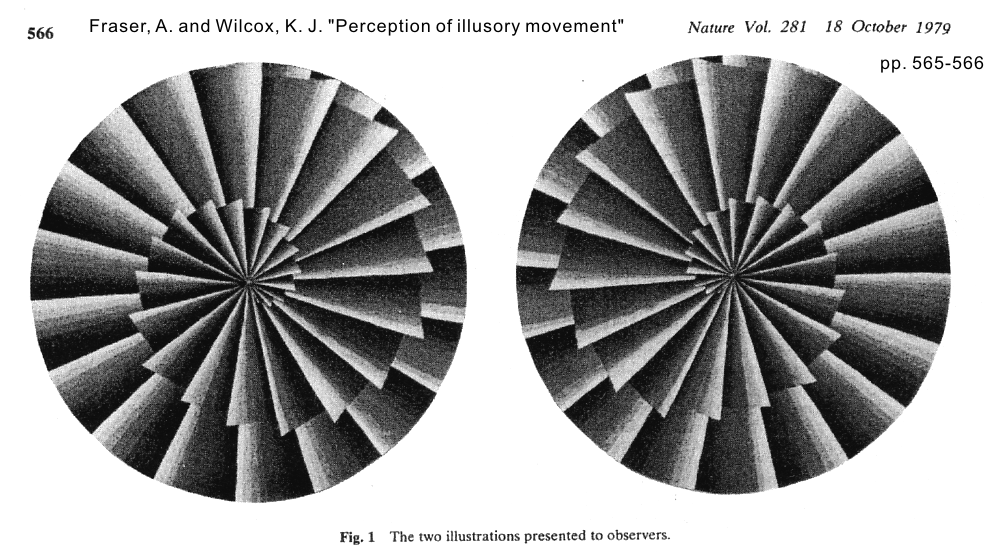
References
Fraser, A. and Wilcox, K. J. (1979). Perception of illusory movement. Nature, 281, 565-566.
Observers saw illusory motion in a stationary image which consists of repeated luminnace gradient in a saw-tooth wave form. Some reported illusory motion from dark to light along a luminance gradient, while others saw the reversal. The illusion is strong in the peripheral viewing. Fraser and Wilcox (1979) claimed that this individual difference depends on some genetic properties.
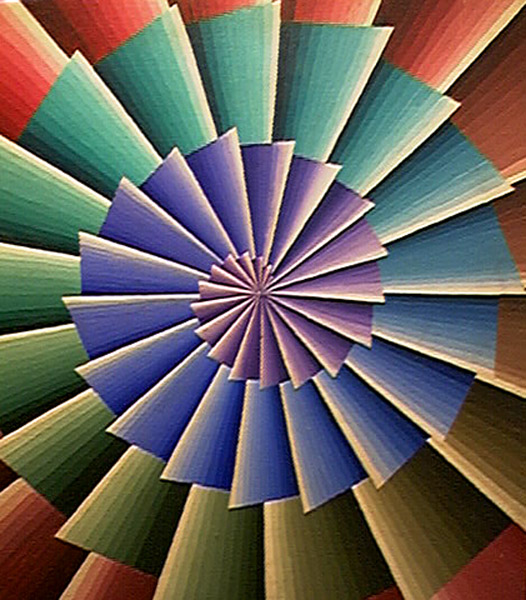
Adopted from “Alex Fraser, Geneticist and Painter”
(http://doctoralexfraser.blogspot.jp/p/spirals.html) <access August 25, 2012> (with permission from Alan Fraser)
Alex Fraser (1923-2002) was a geneticist and a painter.
2. Faubert and Herbert (1999)
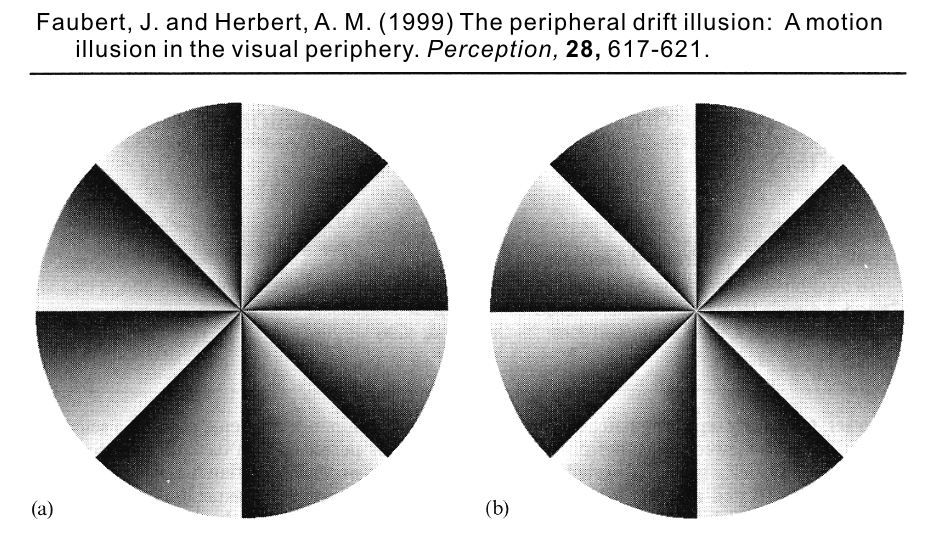
The left disk appears to rotate clockwise while the right one counterclockwise. Faubert and Herbert (1999) reported only illusory motion from dark to light along a luminance gradient. They attributed the illusory motion to the assumed time difference between responses to black and white.
References
Faubert, J. and Herbert, A. M. (1999). The peripheral drift illusion: A motion illusion in the visual periphery. Perception, 28, 617-621.
3. Naor-Raz and Sekuler (2000)
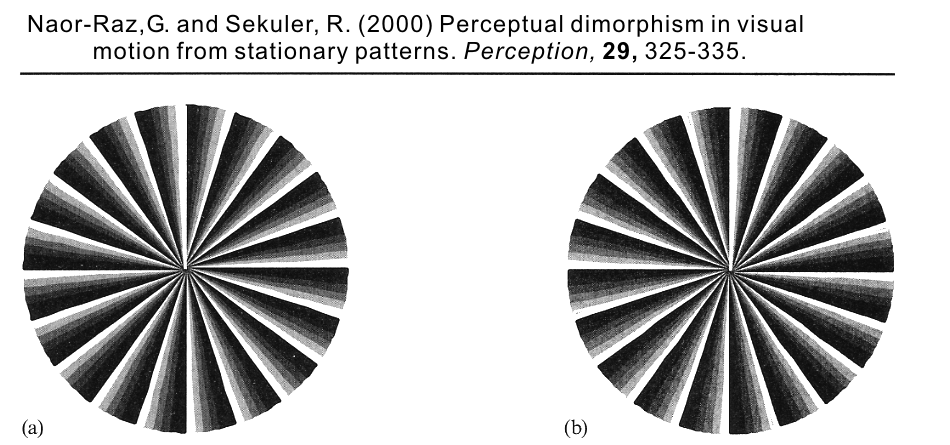
The left disk appears to rotate clockwise while the right one counterclockwise. Naor-Raz and Sekuler (2000), too, reported only illusory motion from dark to light along a luminance gradient. They revealed that the illusion magnitude is a positive, nearly linear function of contrast.
References
Naor-Raz, G. and Sekuler, R. (2000). Perceptual dimorphism in visual motion from stationary patterns. Perception, 29, 325-335.
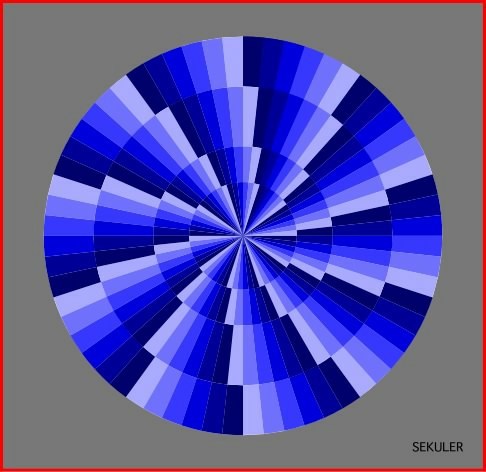
This disk appears to rotate clockwise.
This color illusion image presented by Naor-Raz and Sekuler (2000) (shown
below) might be attributable to this type.
http://www.perceptionweb.com/perception/perc0300/sekuler.jpg <access August 26, 2012>
<with permission from Robert Sekuler>
4. Kitaoka and Ashida (2003)
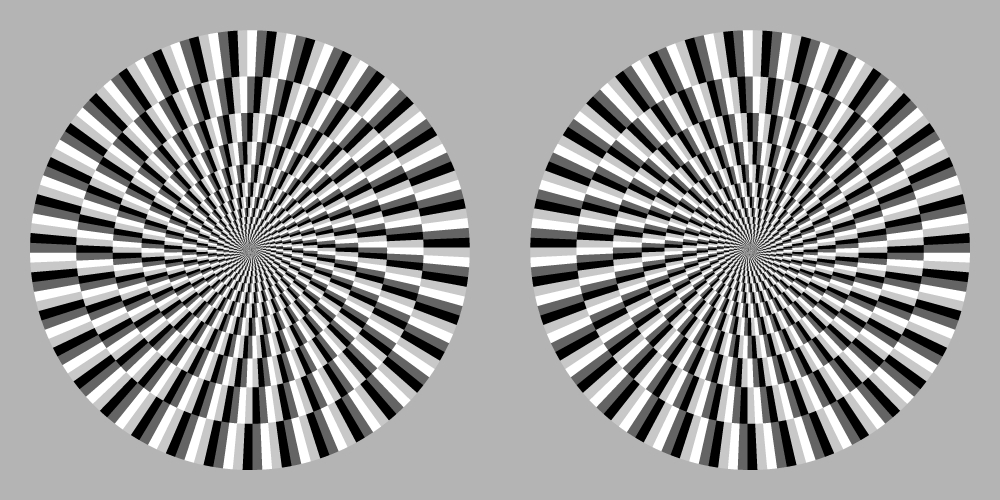
The left disk appears to rotate counterclockwise while the right one clockwise. Kitaoka and Ashida (2003) proposed that the illusory motion is strong when patterns are arranged in the following luminance order: from black, dark-gray, white, light-gray, and back to black.
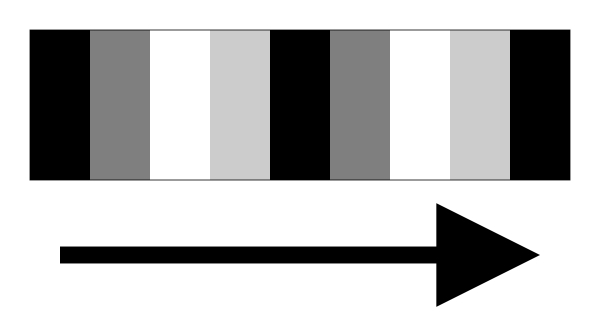
References
Kitaoka, A. and Ashida, H. (2003). Phenomenal characteristics of the peripheral drift illusion. VISION (Journal of the Vision Society of Japan), 15, 261-262. PDF
5. Kitaoka (2007)
Kitaoka (2007) classified the Fraser-Wilcox illusion into Type I, IIa, IIb and III, in each of which the dark-to-light type was distinguished from the light-to-dark one.
References
Kitaoka, A. (2007) Phenomenal classification of the “optimized” Fraser-Wilcox illusion and the effect of color. Poster presentation in DemoNight, VSS2007, GWiz, Sarasota, Florida, USA, May 14, 2007.
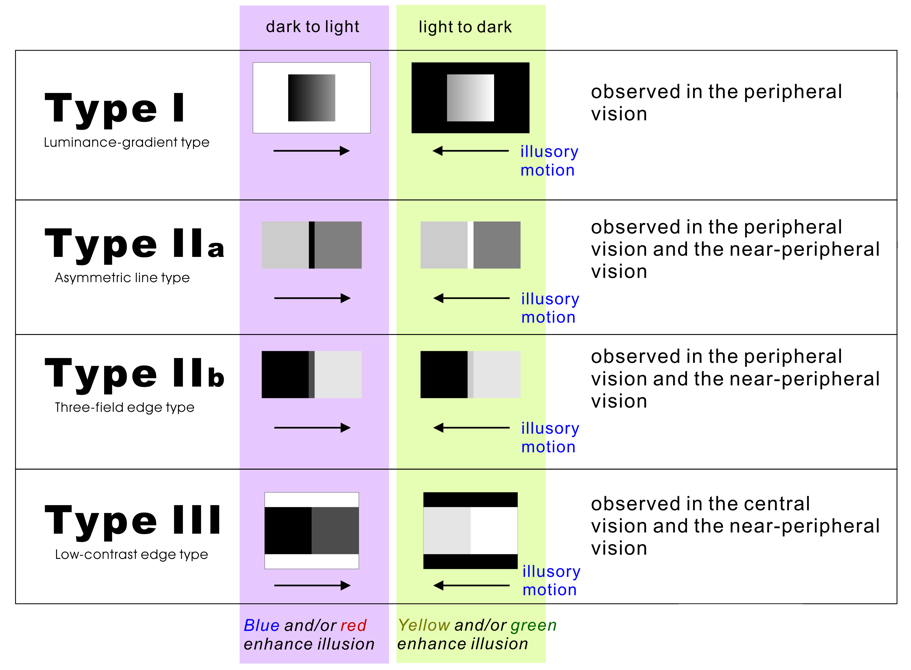
Type I
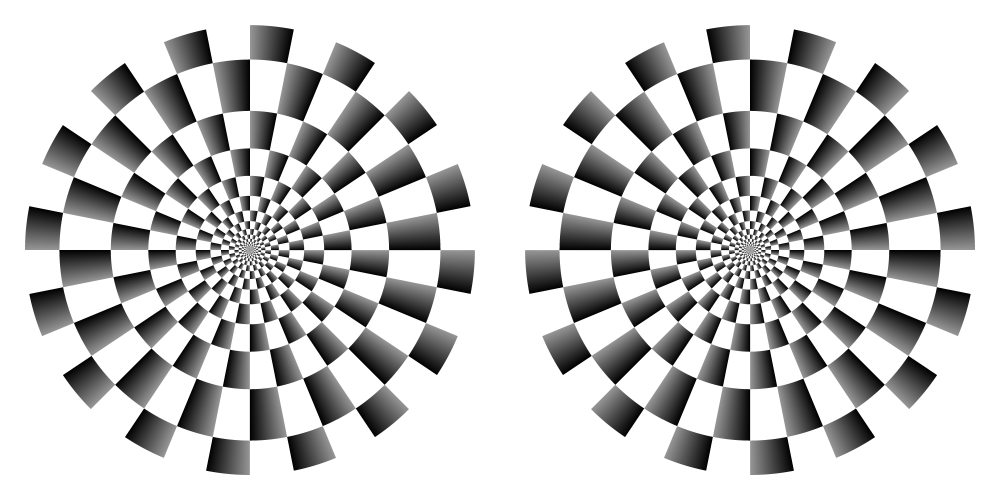
"Dark to light"
The left disk appears to rotate counterclockwise while the right one clockwise.
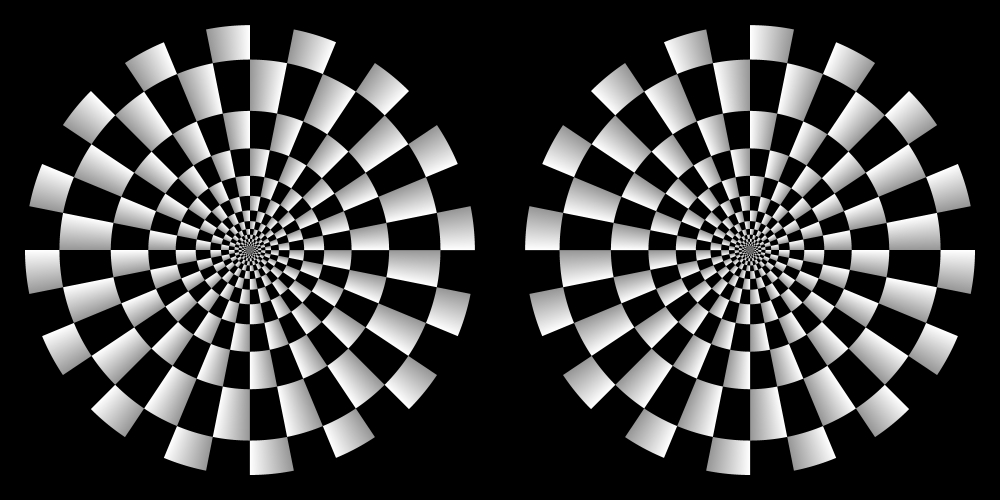
"Light to dark"
The left disk appears to rotate counterclockwise while the right one clockwise.
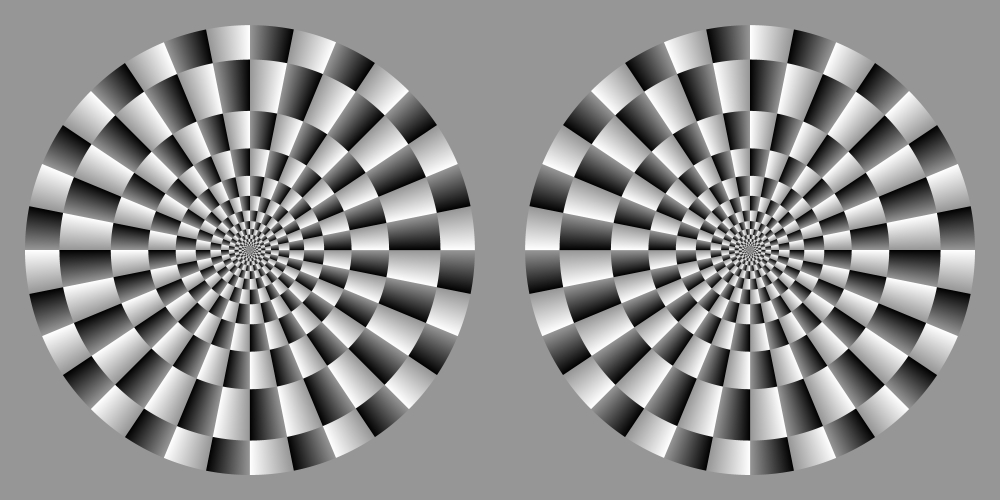
"Dark to light" and "light to dark" combined
The left disk appears to rotate counterclockwise while the right one clockwise.
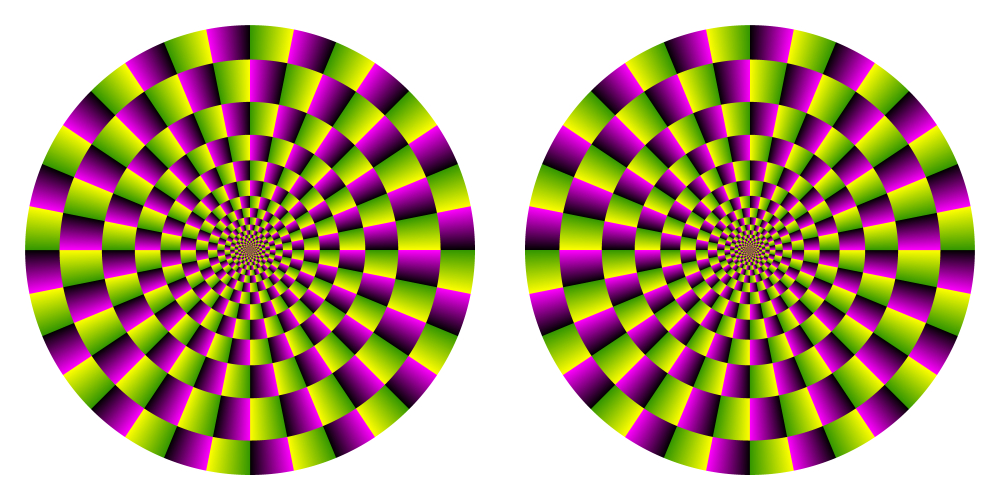
"Dark to light" and "light to dark" combined, with
color enhancement
The left disk appears to rotate counterclockwise while the right one clockwise.
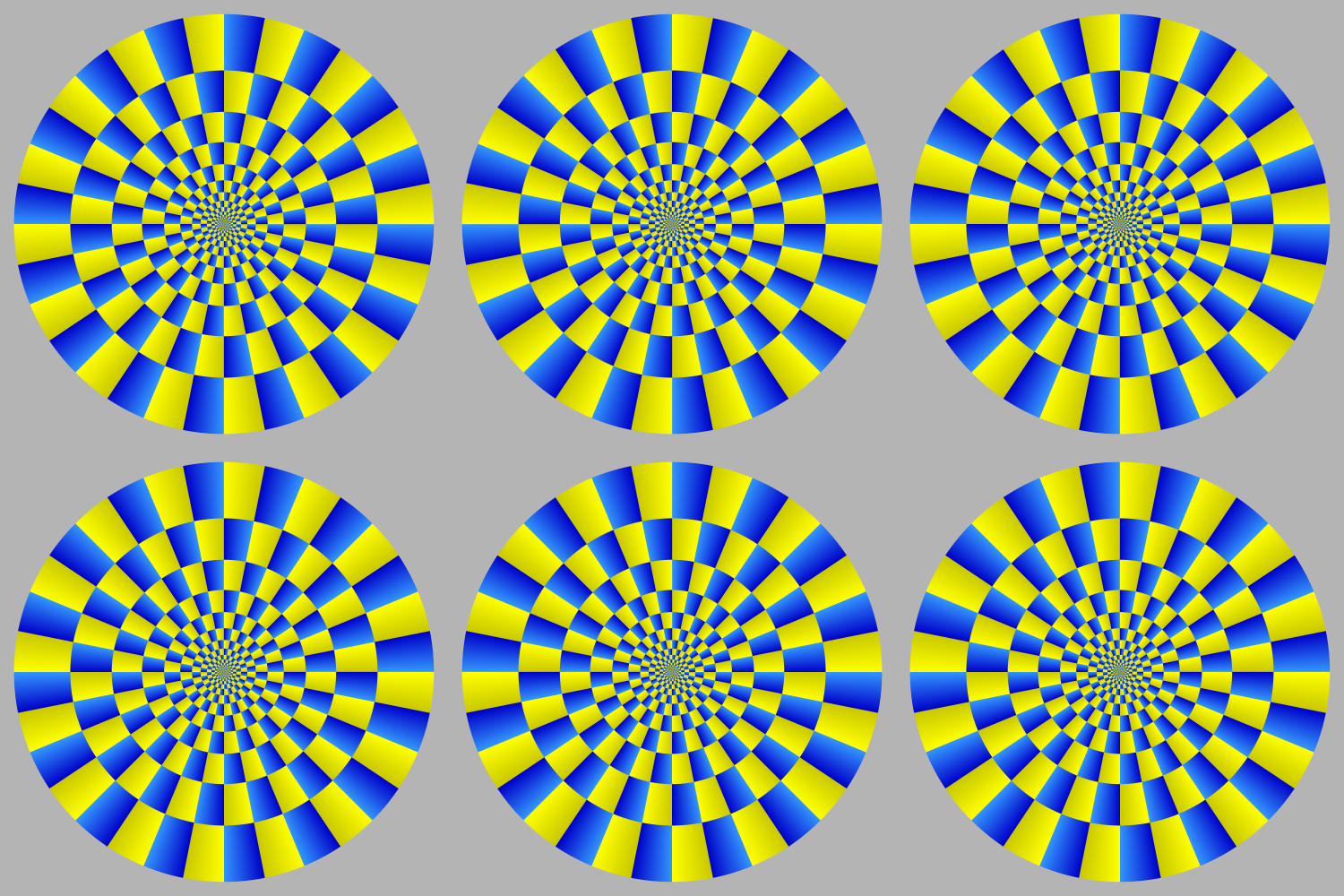
The upper-left, upper-right, and lower-middle disks appear to rotate counterclockwise
while the rest clockwise.
Type I (six disks) 1500 x 1000 (pixel)
Type I (six disks) 6000 x 4000 (pixel)
Type II
Type IIa
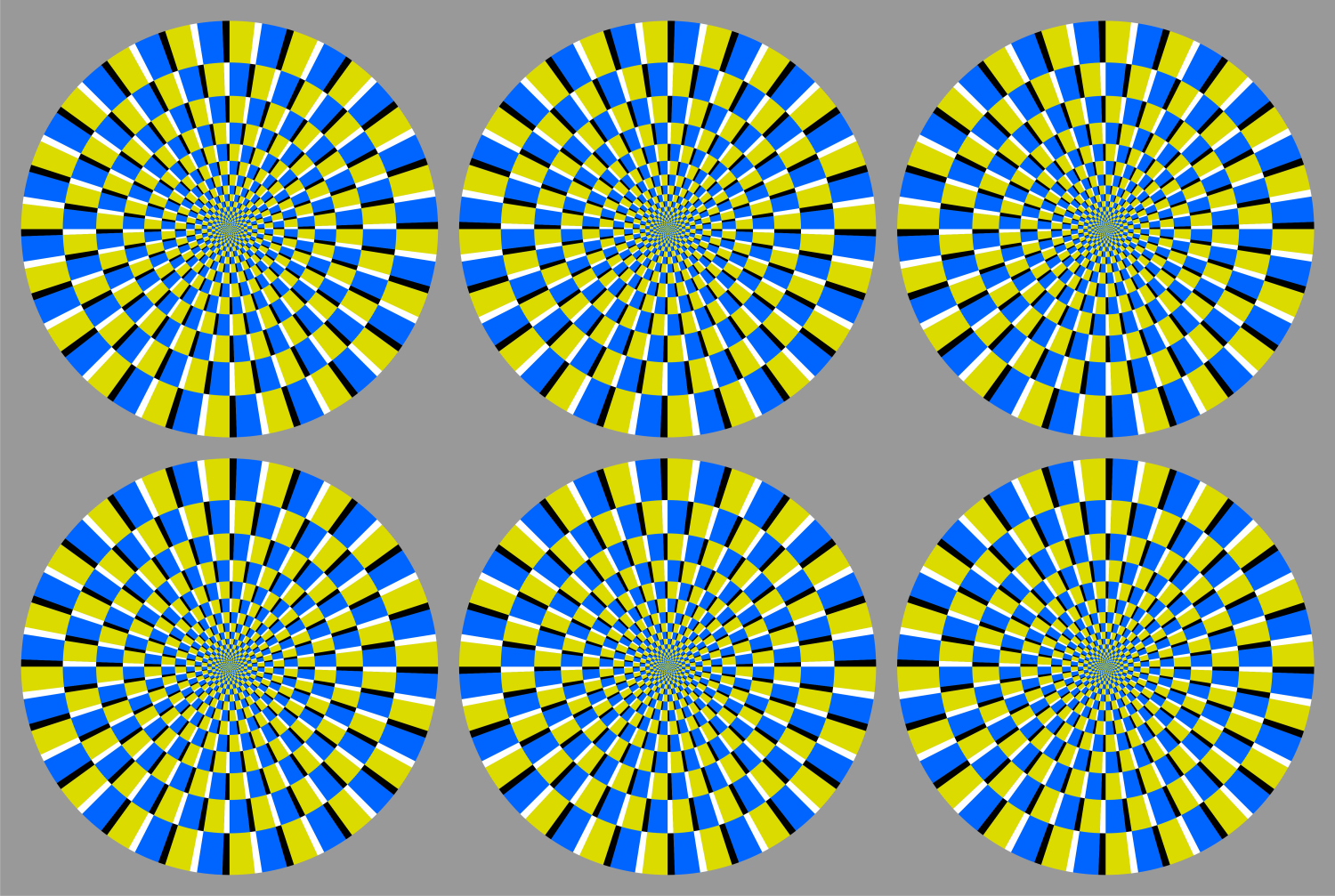
The upper-left, upper-right, and lower-middle disks appear to rotate counterclockwise
while the rest clockwise.
Type IIb
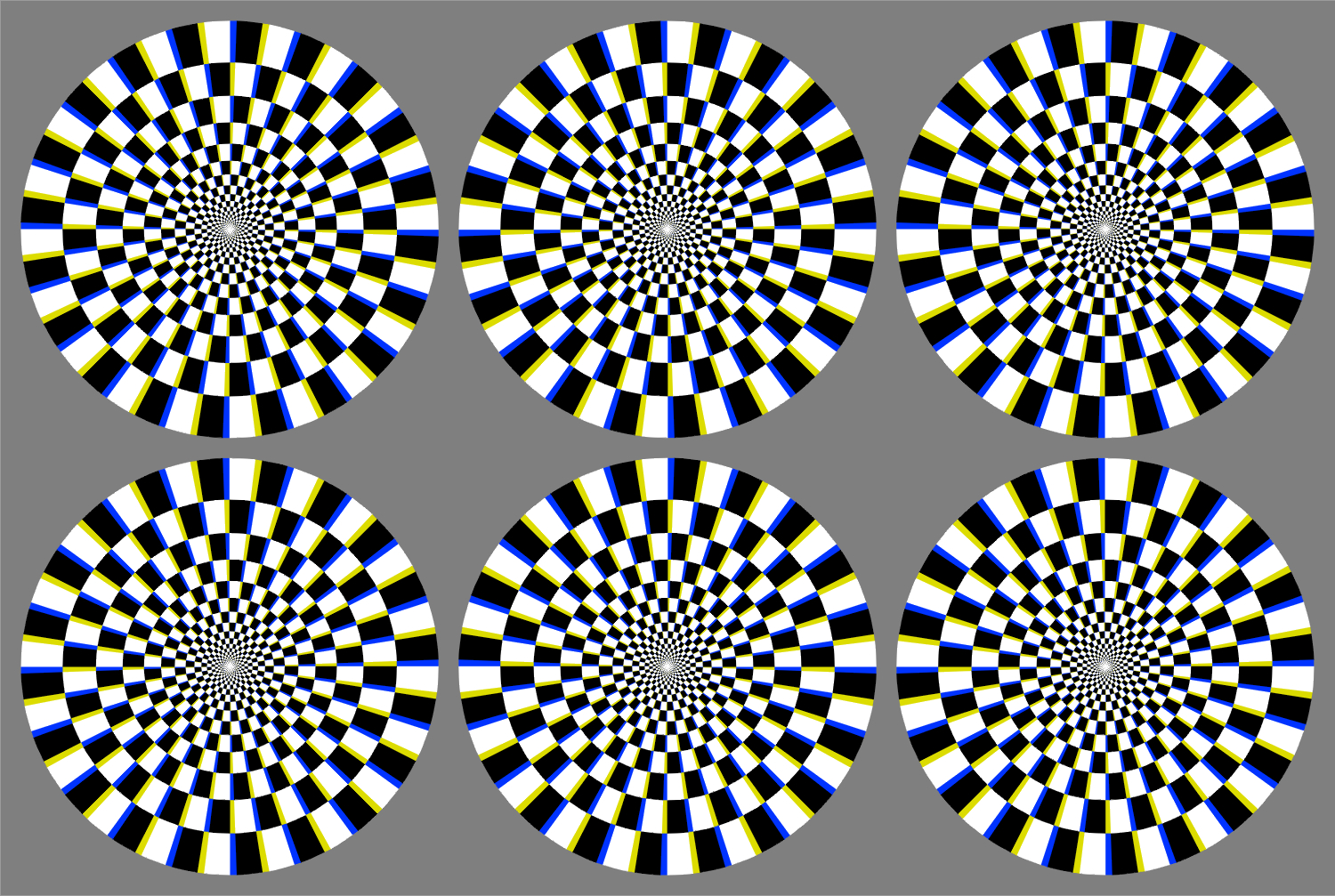
The upper-left, upper-right, and lower-middle disks appear to rotate counterclockwise while the rest clockwise.
Type IIa (six disks) 1500 x 1007 (pixel)
Type IIa (six disks) 6000 x 4031 (pixel)
Type IIb (six disks) 1500 x 1000 (pixel)
Type IIb (six disks) 6000 x 4000 (pixel)
"Rotating snakes"
(Ver. 2011)
Each disk appears to rotate.
Copyright Akiyoshi Kitaoka 2011 (January 23)
Adjusted for printing using EPSON PM-4000PX
Type III

The upper row appears to move rightward while the lower one leftward.
Type III (two rows) 1500 x 400 (pixel)
Type III (two rows) 4500 x 1200 (pixel)Type III 4500 x 1200
.jpg)
The upper-left, upper-right, and lower-middle disks appear to rotate counterclockwise
while the rest clockwise.
6. Kitaoka (2008a, b)
"Type IV" was added to the list.
References
Kitaoka, A. (2008a). Optimized Fraser-Wilcox illusions: a pictorial classification by Akiyoshi Kitaoka. Talk in Workshop No.005 "Experimental studies of anomalous motion illusions" in the 72nd Annual Convention of the Japanese Psychological Association, Hokkaido University, Sapporo, Japan, September 19, 2008. Talk
Kitaoka, A. (2008b). A new type of the optimized Fraser-Wilcox illusion in a 3D-like 2D image with highlight or shade. Journal of Three Dimensional Images (Japan), 22(4), 31-32. PDF PDF (manuscript) Presentation
Type IV
m.jpg)
The upper-left, upper-right, and lower-middle rings appear to rotate counterclockwise
while the rest clockwise.
Findings of the "Rotating snakes" illusion (optimized Fraser-Wilcox illusion)
1. Illusion is strong in the peripheral vision
Kitaoka, A. and Ashida, H. (2003) Phenomenal characteristics of the peripheral drift illusion. VISION, 15, 261-262.PDF
2. Illusion is strong when the image is of high luminance
Hisakata, R. and Murakami, I. (2008) The effects of eccentricity and retinal illuminance on the illusory motion seen in a stationary luminance gradient. Vision Research, 49, 1940-1948.
3. Illusion requires some eye movement
Murakami, I., Kitaoka, A. and Ashida, H. (2006) A positive correlation between fixation instability and the strength of illusory motion in a static display. Vision Research, 46, 2421-2431.
Kuriki, I., Ashida, H., Murakami, I., and Kitaoka, A. (2008) Functional brain imaging of the Rotating Snakes illusion by fMRI. Journal of Vision, 8(10):16, 1-10.
4. Illusion does not occur in the stabilized retinal image
Murakami, I., Kitaoka, A. and Ashida, H. (2006) A positive correlation between fixation instability and the strength of illusory motion in a static display. Vision Research, 46, 2421-2431.
5. Illusion is enhanced by color
Kitaoka, A. (2007) Phenomenal classification of the “optimized” Fraser-Wilcox illusion and the effect of color. Poster presentation in DemoNight, VSS2007, GWiz, Sarasota, Florida, USA, May 14, 2007.
6. Illusion is weak when the image is moved
Tomimatsu, E., Ito, H., Seno, T., and Sunaga, S. (2010) The ‘rotating snakes’ in smooth motion do not appear to rotate. Perception, 39, 721-724.
7. Illusion is weak when the image is observed through pinholes
Cantor, C. R. L., Tahir, H. J., and Shor, C. M. (2010) Is the rotating snakes an optical illusion? VSS2010, #26.434.
8. Illusion activates V1 through hMT+ areas
Kuriki, I., Ashida, H., Murakami, I., and Kitaoka, A. (2008) Functional brain imaging of the Rotating Snakes illusion by fMRI. Journal of Vision, 8(10):16, 1-10.
Ashida, H., Kuriki, I., Murakami, I., Hisakata, R. and Kitaoka, A. (2012). Direction-specific fMRI adaptation reveals the visual cortical network underlying the "Rotating Snakes" illusion. NeuroImage, 61, 1143–1152.
Major models of the "Rotating snakes" illusion (optimized Fraser-Wilcox illusion)
1. Adaptation (temporal positional shift)
Backus, B. T. and Oruç, I. (2005) Illusory motion from change over time in the response to contrast and luminance. Journal of Vision, 5, 1055-1069.
2. Visual delay (temporal positional shift) related issue 1 _ related issue 2
Conway, R. B., Kitaoka, A., Yazdanbakhsh, A., Pack, C. C., and Livingstone, M. S. (2005) Neural basis for a powerful static motion illusion. Journal of Neuroscience, 25, 5651-5656.
3. Motion signal asymmetry
Murakami, I., Kitaoka, A. and Ashida, H. (2006) A positive correlation between fixation instability and the strength of illusory motion in a static display. Vision Research, 46, 2421-2431.
7. Kitaoka (2008, 2010, 2012a, b)
A strongly color-dependent, "reddish" version was added to the list.
In 2008, Kitaoka found that the direction of illusory motion is “red → dark purple → purple → magenta (light red-purple) → red”, and that the illusion magnitude is strong when overall luminance contrast is low. Images of high luminance make a strong effect.
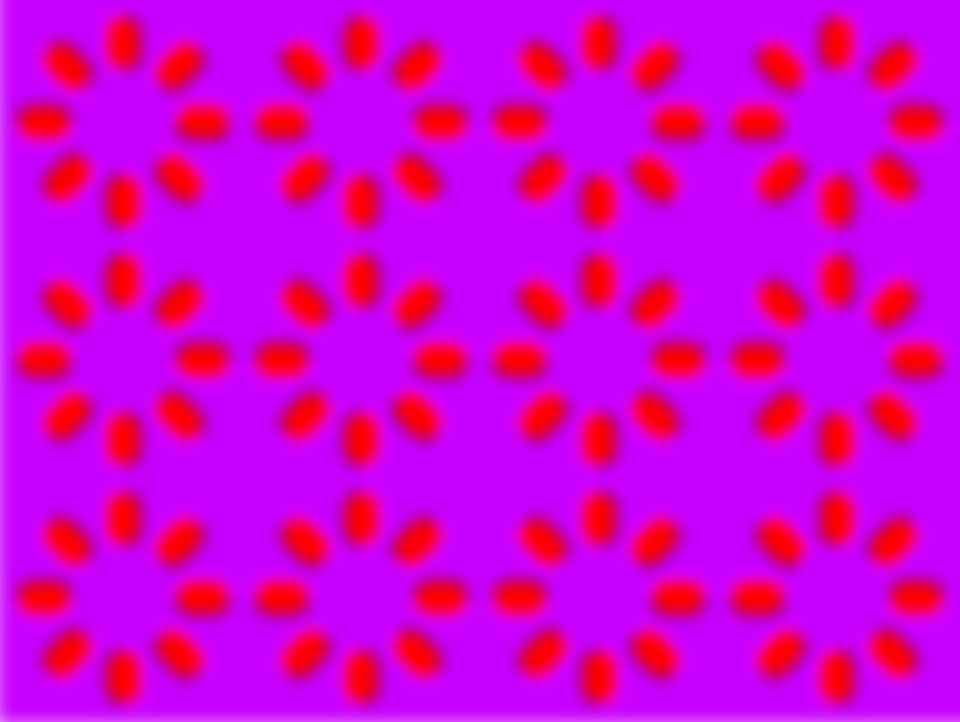
"Rotating red fruits"
Rings of fruits appear to rotate.
Copyright Akiyoshi Kitaoka 2008 (December 19)
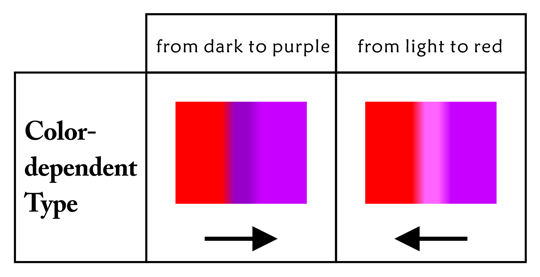
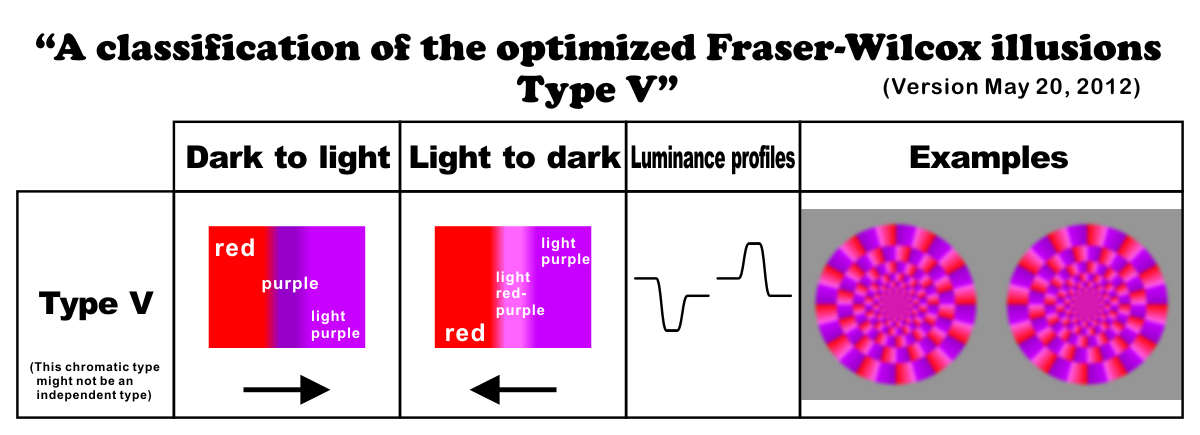
Purple » light purple » light red-purple » red » purple
References
Kitaoka, A. (2010). Introduction to visual illusion. Tokyo: Asakura-shoten (in Japanese). Book
Kitaoka, A. (2012a). Designs using the red Fraser-Wilcox illusion. Journal
of the Color Science Association of Japan, 36, Supplement, 188-189. PDF (color manuscript) Talk
Kitaoka, A. (2012b) The Fraser-Wilcox illusion and its extension. Perception 41 ECVP Abstract Supplement, page 91 (Poster September 3, 2012). Poster PDF
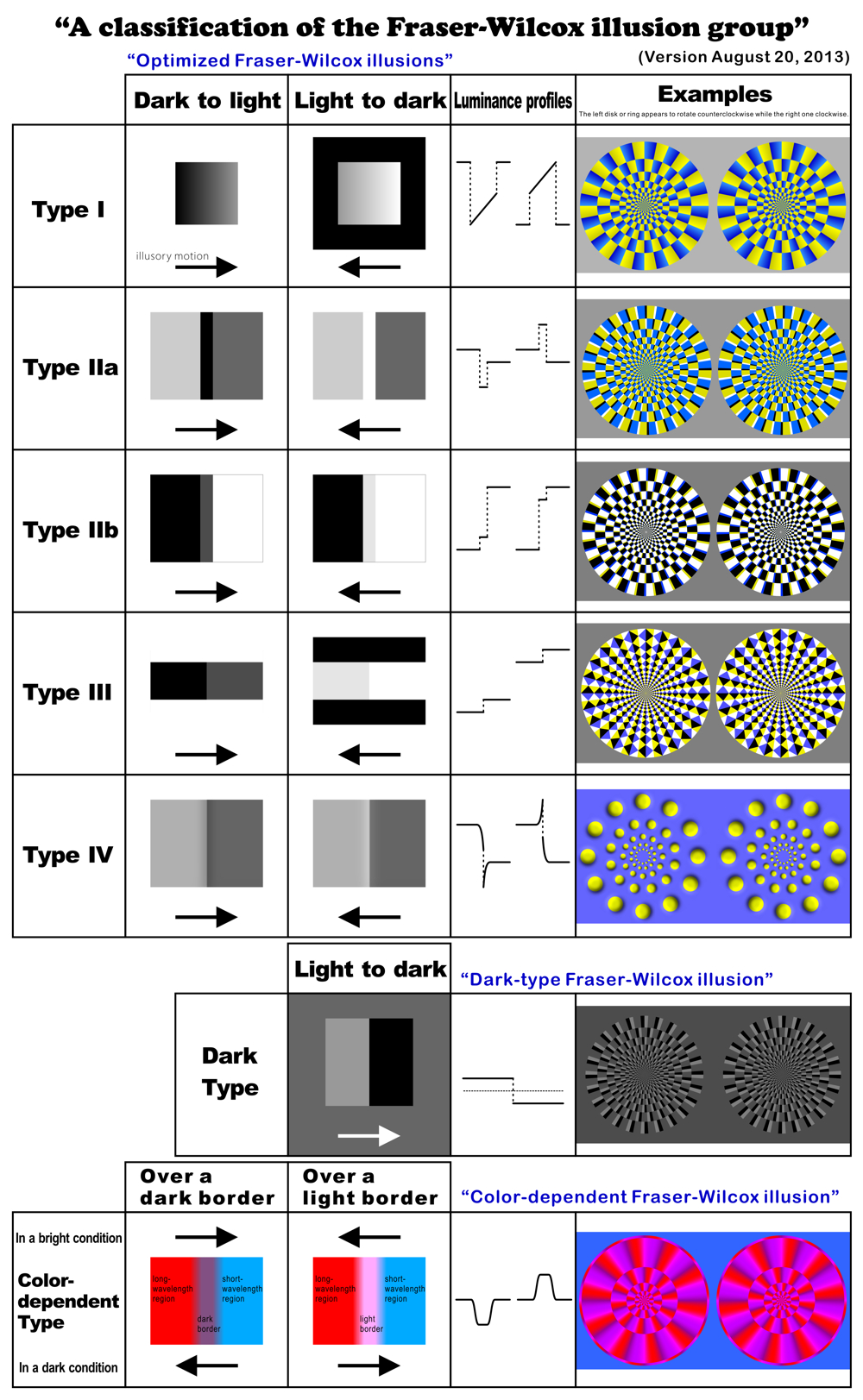
8. Kitaoka (2011)
In 2011, Kitaoka found that flickering the image increases the illusion magnitude. Blinks also work.
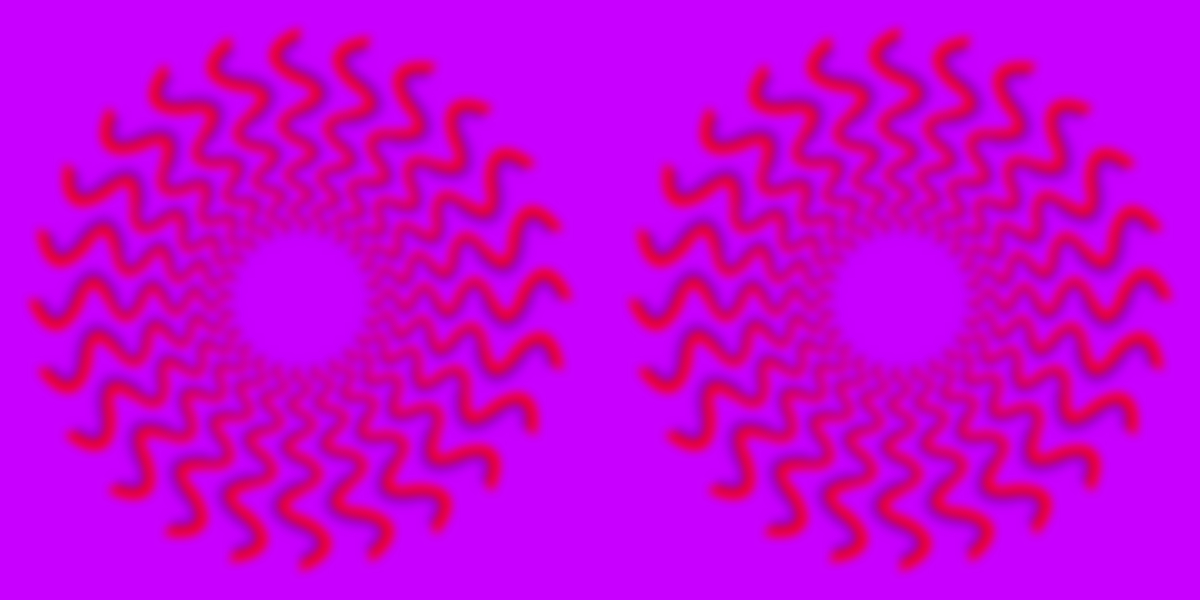
Copyright Akiyoshi Kitaoka 2012 (June 14)
Further studies on the flickering enhancement or induction (Kitaoka, 2013)
Flickering induction depends on the interaction between the stimulus and the blank.
Each disk appears to rotate clockwise during fading-in while counterclockwise during fading-out.
Copyright Akiyoshi Kitaoka 2013 (February 19)
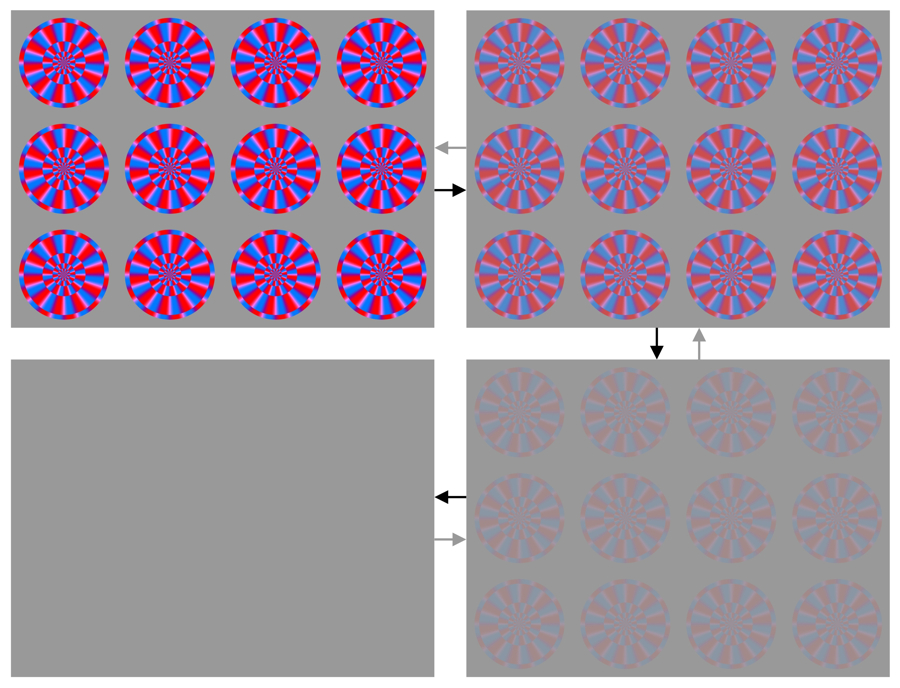
Copyright Akiyoshi Kitaoka 2013 (August 20)
Each disk appears to rotate clockwise during fading-in while counterclockwise during fading-out.
Copyright Akiyoshi Kitaoka 2013 (April 19)
Each disk appears to rotate counteclockwise during fading-in while clockwise during fading-out.
Copyright Akiyoshi Kitaoka 2013 (April 19)
Each disk appears to rotate counteclockwise during fading-in while clockwise during fading-out.
Copyright Akiyoshi Kitaoka 2013 (April 19)
Each disk appears to expand during fading-in while to contract during fading-out.
Copyright Akiyoshi Kitaoka 2013 (April 20)
"On-off rotating snakes: red and sky blue #1"
When fading in, each disk appears to rotate in the direction: black, red, white, sky blue, black. The direction is reversed when fading out.
Copyright Akiyoshi Kitaoka 2013 (April 30)
"On-off rotating snakes: red and sky blue #2"
When fading in, each disk appears to rotate in the direction: black, sky blue, white, red, black. The direction is reversed when fading out.
Copyright Akiyoshi Kitaoka 2013 (April 30)
9. Yanaka and Hirano (2011)
Yanaka and Hilano (2011) reported that this illusion is enhanced by mechanical shaking.
Each disk appears to rotate counterclockwise.
(Note that this movie is not their original)
References
Yanaka, K. and Hilano, T. (2011). Mechanical shaking system to enhance
"Optimized Fraser–Wilcox Illusion Type V". Perception, 40, ECVP
Abstract Supplement, page 171.
10. Yanaka (2012)
Yanaka (2012) reported that this illusion is enhanced by viewing images under dark illumination.
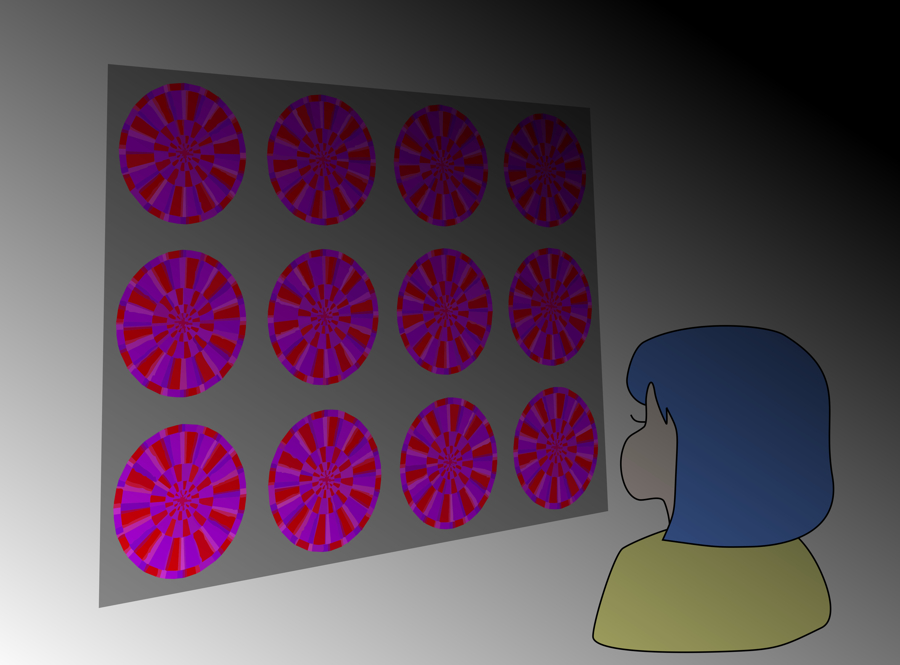
References
Yanaka, K. (2012). Enhancement of the optimized Fraser-Wilcox illusion Type V by swinging the image. Talk in the 5th Illusion Workshop, Meiji University, Tokyo, Japan, September 18, 2012.
11. Kitaoka (2013)
In 2013, Kitaoka (ECVP2013) found that Yanaka’s darkening enhancement is accompanied by a reversal of illusion: i.e., the direction under dark condition is “red → magenta (light red-purple) → purple → dark purple → red”.
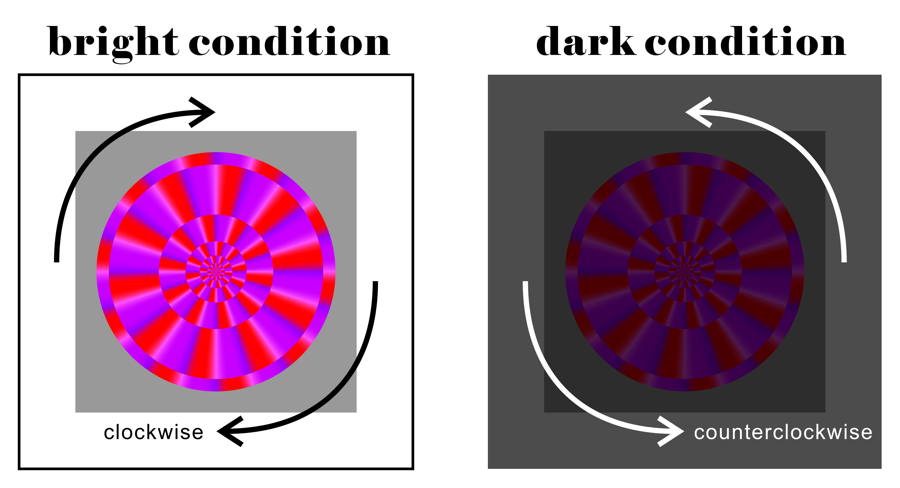
References
Kitaoka, A. (2013). Invisible color and visible color: Mystery of color the brain feels. Talk in the Shizuoka Science Museum Ru-Ku-Ru, Shizuoka, Japan, January 13, 2013. Talk
12. Kitaoka (2013)
In 2013, Kitaoka (ECVP2013) found that combination of a long wavelength color and a short one makes the illusions.
Illusory motion depending on the combination of colors

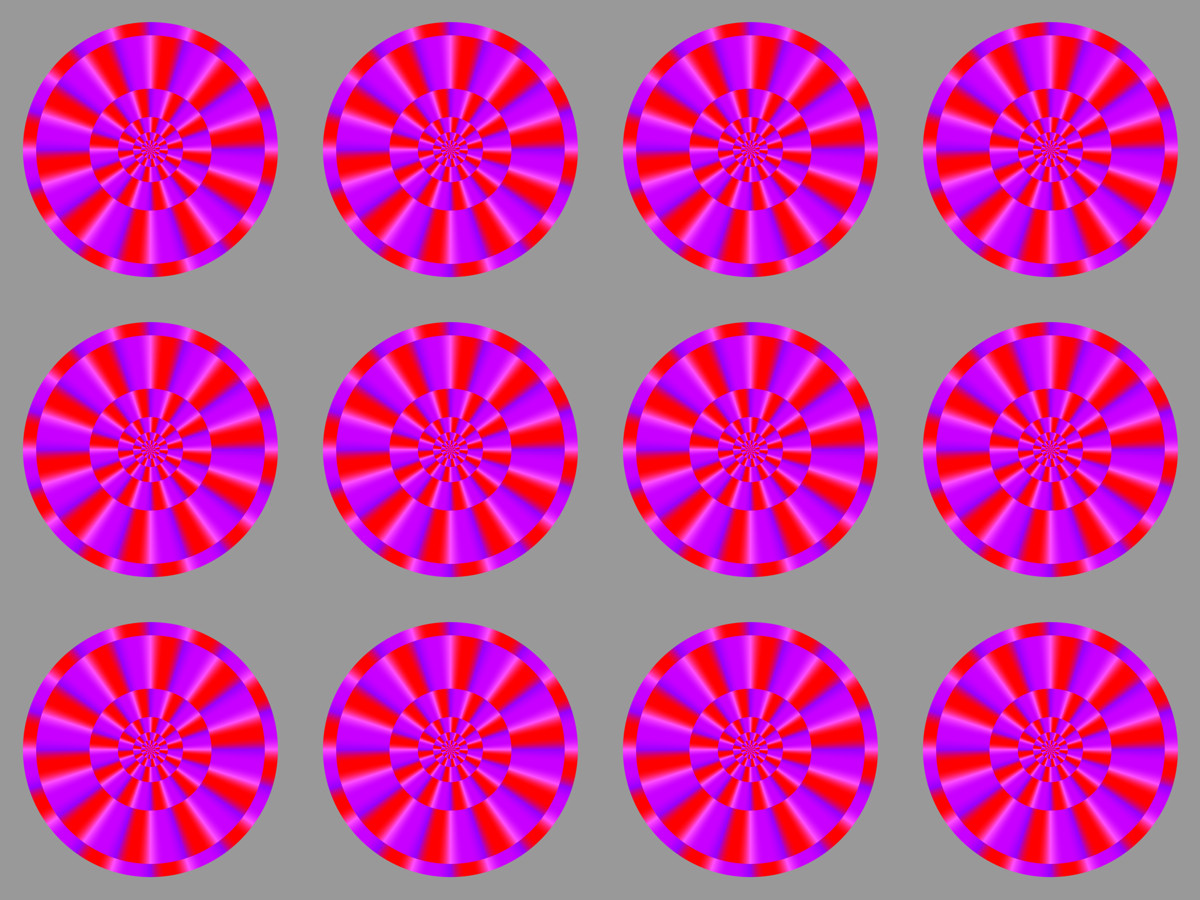
"Rotating red-and-purple disks"
Each disk appears to rotate clockwise on a bright display, while it appears to rotate counterclockwise with a printed image under dark illumination.
Copyright Akiyoshi Kitaoka 2013 (February 6)
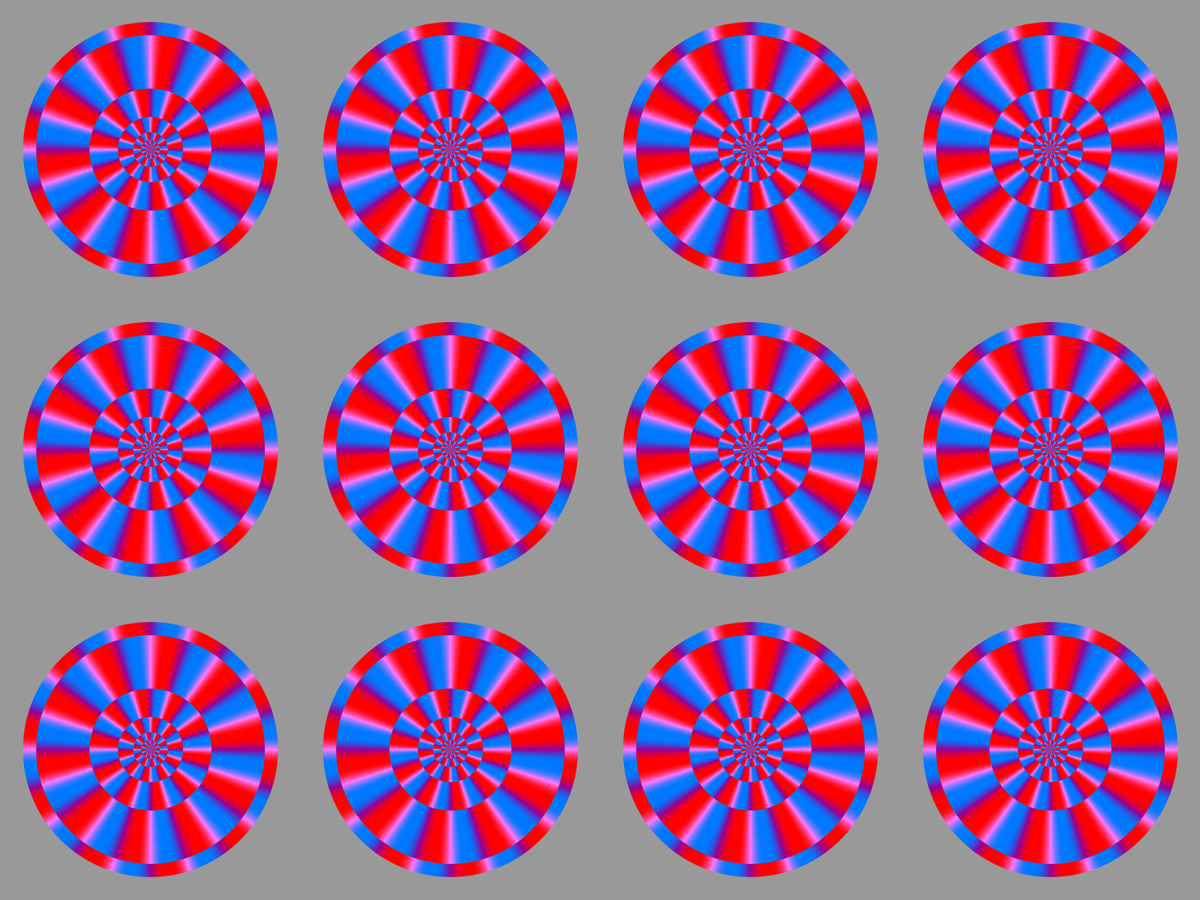
"Rotating red-and-cyan disks"
Each disk appears to rotate clockwise on a bright display, while it appears to rotate counterclockwise with a printed image under dark illumination.
Copyright Akiyoshi Kitaoka 2013 (February 1)
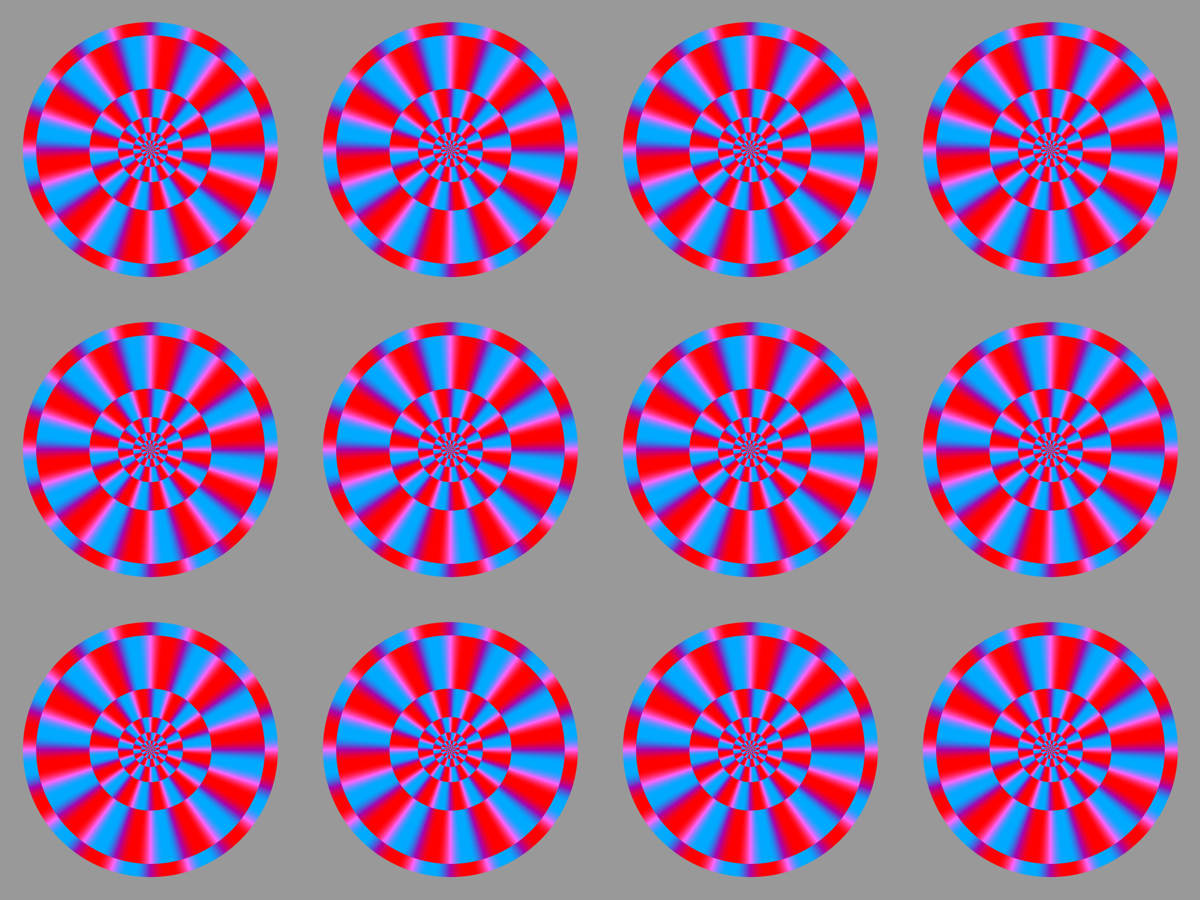
"Rotating red-and-cyan disks 2"
Each disk appears to rotate clockwise on a bright display, while it appears to rotate counterclockwise with a printed image under dark illumination.
Copyright Akiyoshi Kitaoka 2013 (February 6)
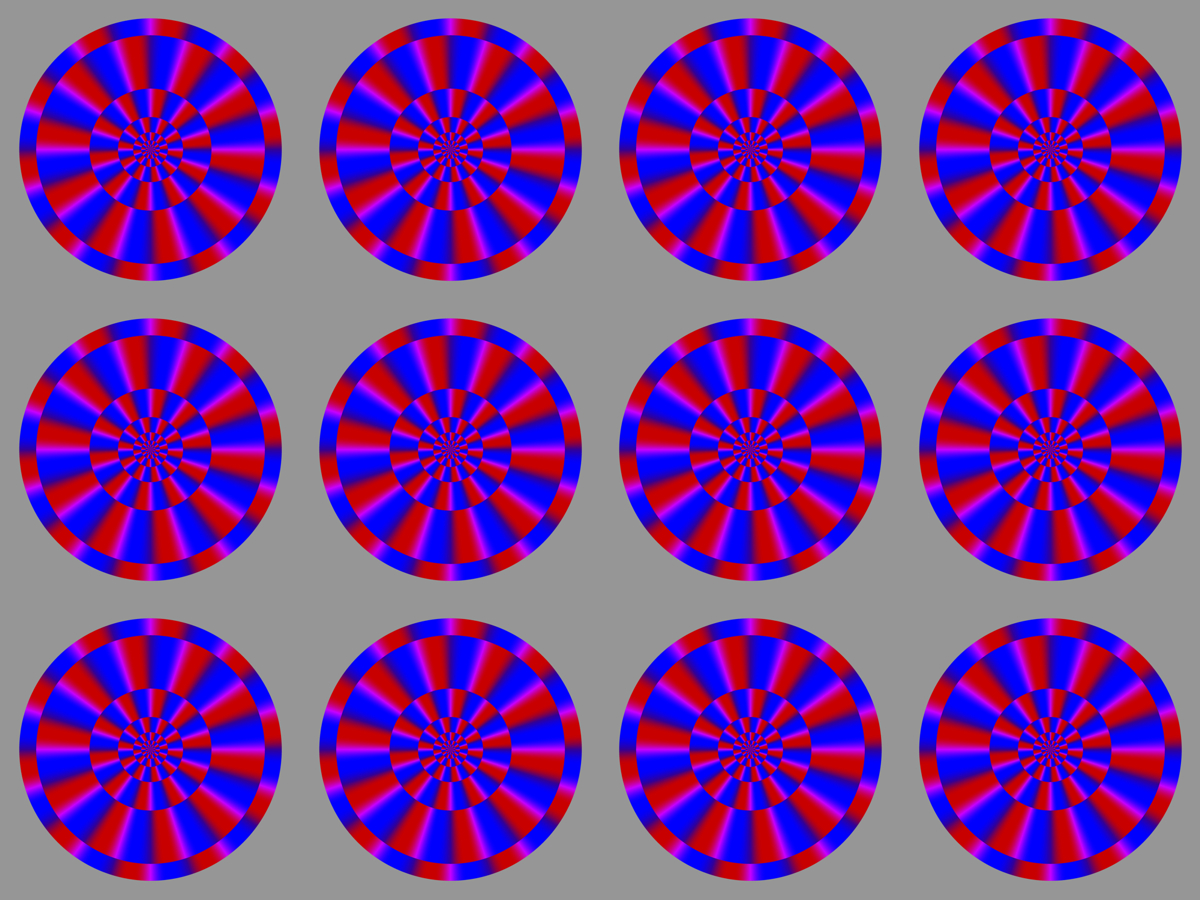
"Rotating red-and-blue disks"
Each disk appears to rotate clockwise on a bright display, while it appears to rotate counterclockwise with a printed image under dark illumination.
Copyright Akiyoshi Kitaoka 2013 (January 29)
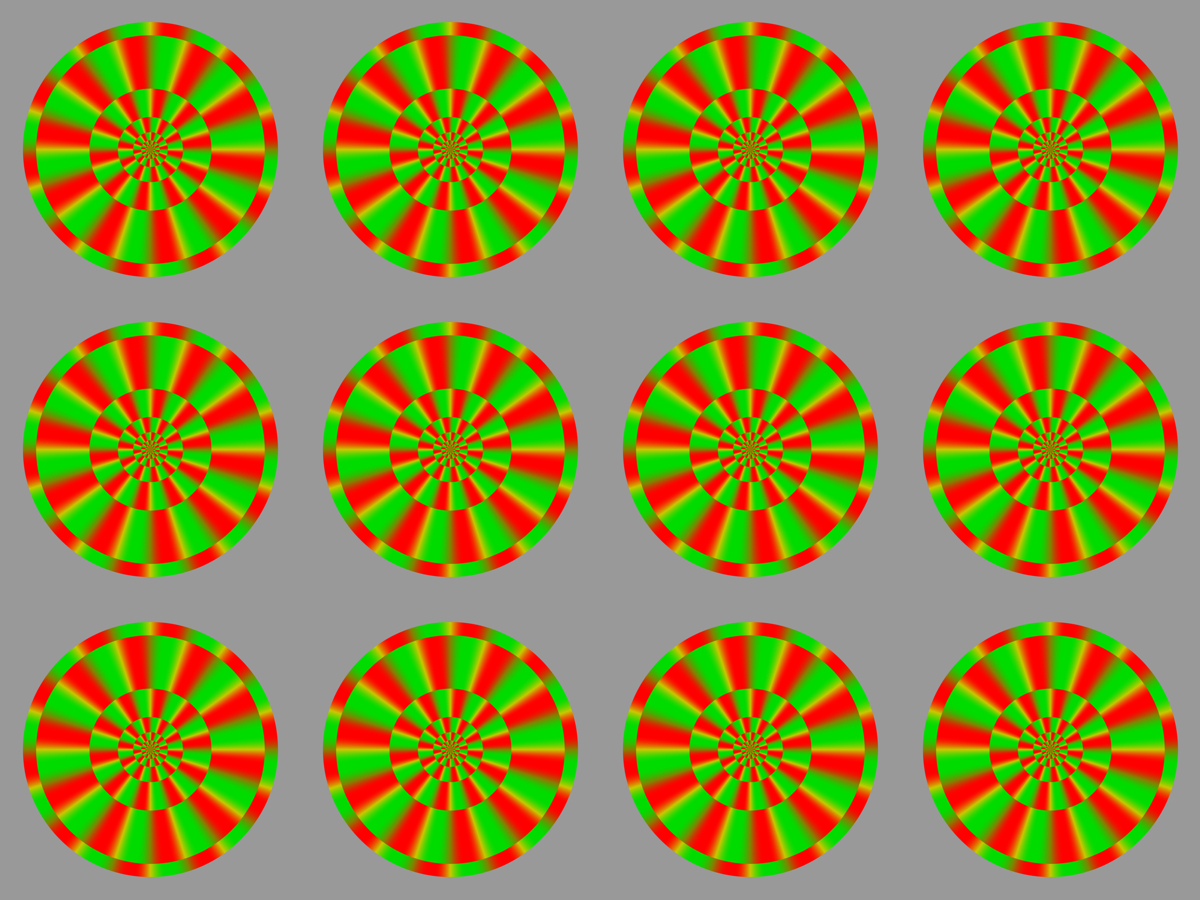
"Rotating red-and-green disks"
Each disk appears to rotate clockwise on a bright display, while it appears to rotate counterclockwise with a printed image under dark illumination.
Copyright Akiyoshi Kitaoka 2013 (January 29)
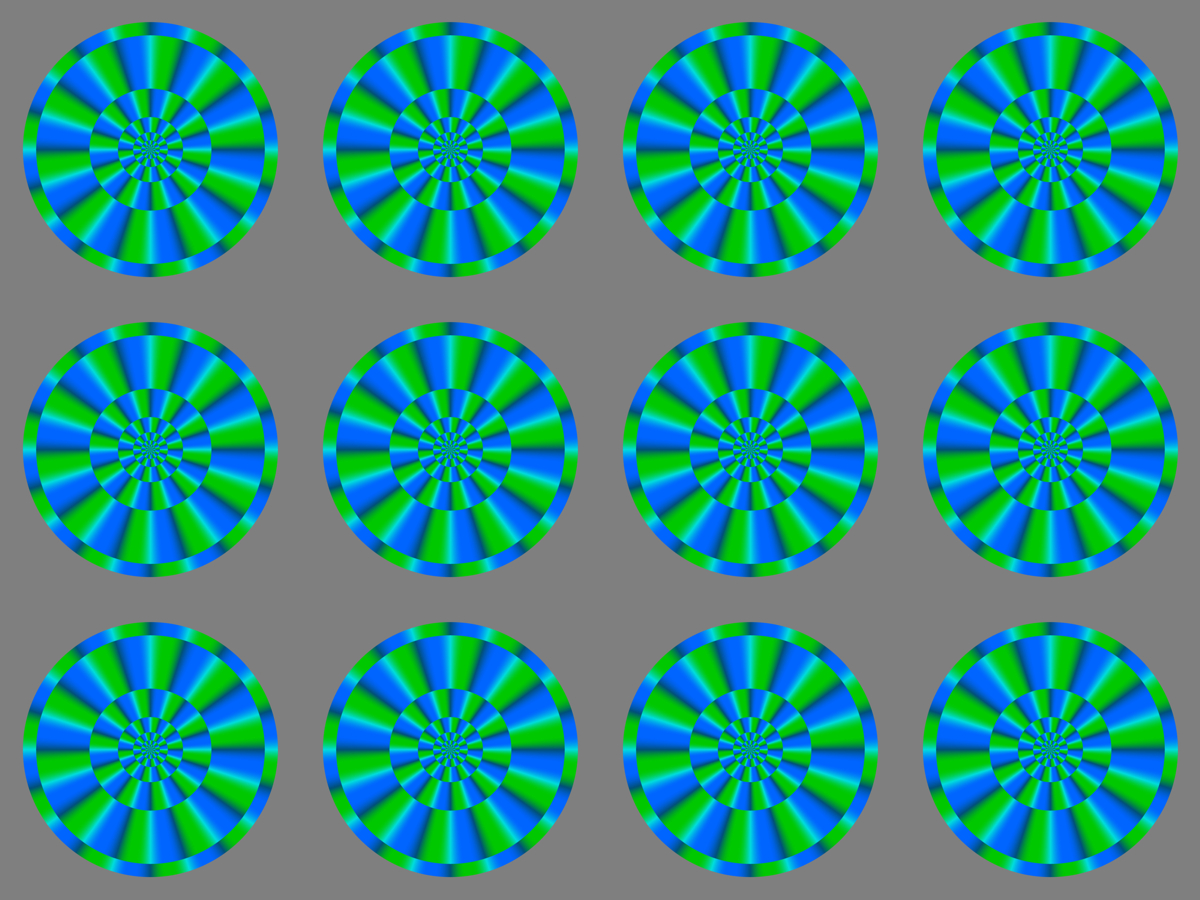
"Rotating blue-and-green disks"
Each disk appears to rotate clockwise on a bright display, while it slightly appears to rotate counterclockwise with a printed image under dark illumination.
Copyright Akiyoshi Kitaoka 2013 (February 6)
13. Kitaoka (2013)
In 2013, Kitaoka (ECVP2013) found that increasing or decreasing illumination makes the illusions.
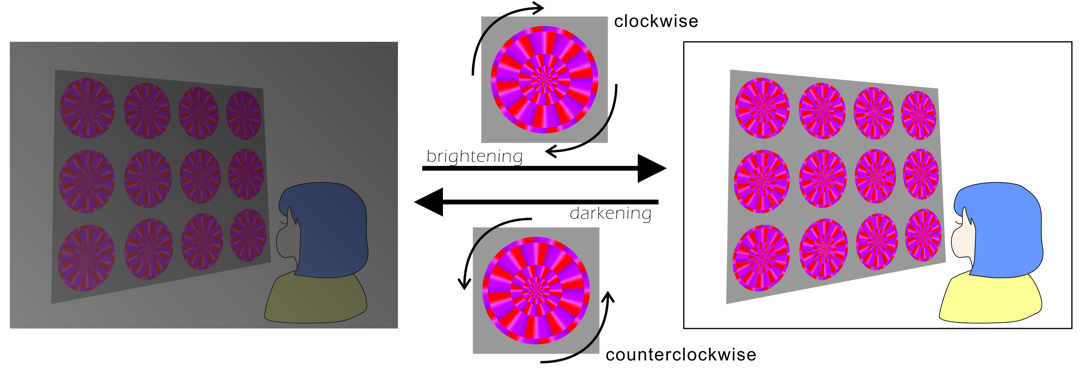
14. Kitaoka (2013)
It is suggested that this ‘luminance change-induced’ motion* might generate
the color-dependent Fraser-Wilcox illusion, being triggered by saccades,
blinks, flickering or shaking the images.
*The luminance change-induced’ motion includes the reverse phi phenomenon
(Anstis, 1970; Anstis and Rogers, 1975) and the phenomenal phenomena (Gregory
and Heard, 1983). Directions of illusory motion depending on the changes
of luminance are shown in the right (Kitaoka, 2006).
References
Anstis S M, 1970 “Phi movement as a subtraction process” Vision Research 10 1411-1430
Anstis S M, Rogers B J, 1975 “Illusory reversal of visual depth and movement
during changes of contrast” Vision Research 15 957-961
Gregory R L, Heard P F, 1983 “Visual dissociations of movement, position,
and stereo depth: some phenomenal phenomena” Quarterly Journal of Experimental
Psychology 35A 217-237
Kitaoka, A. (2006). Configurational coincidence among six phenomena: A
comment on van Lier and Csathó (2006). Perception,
35, 799-806. animations --- PDF
"Rotating gray-scale disks (movie)"
Disks appear to rotate clockwise or counterclockwise.
Copyright Akiyoshi Kitaoka 2013 (February 15)
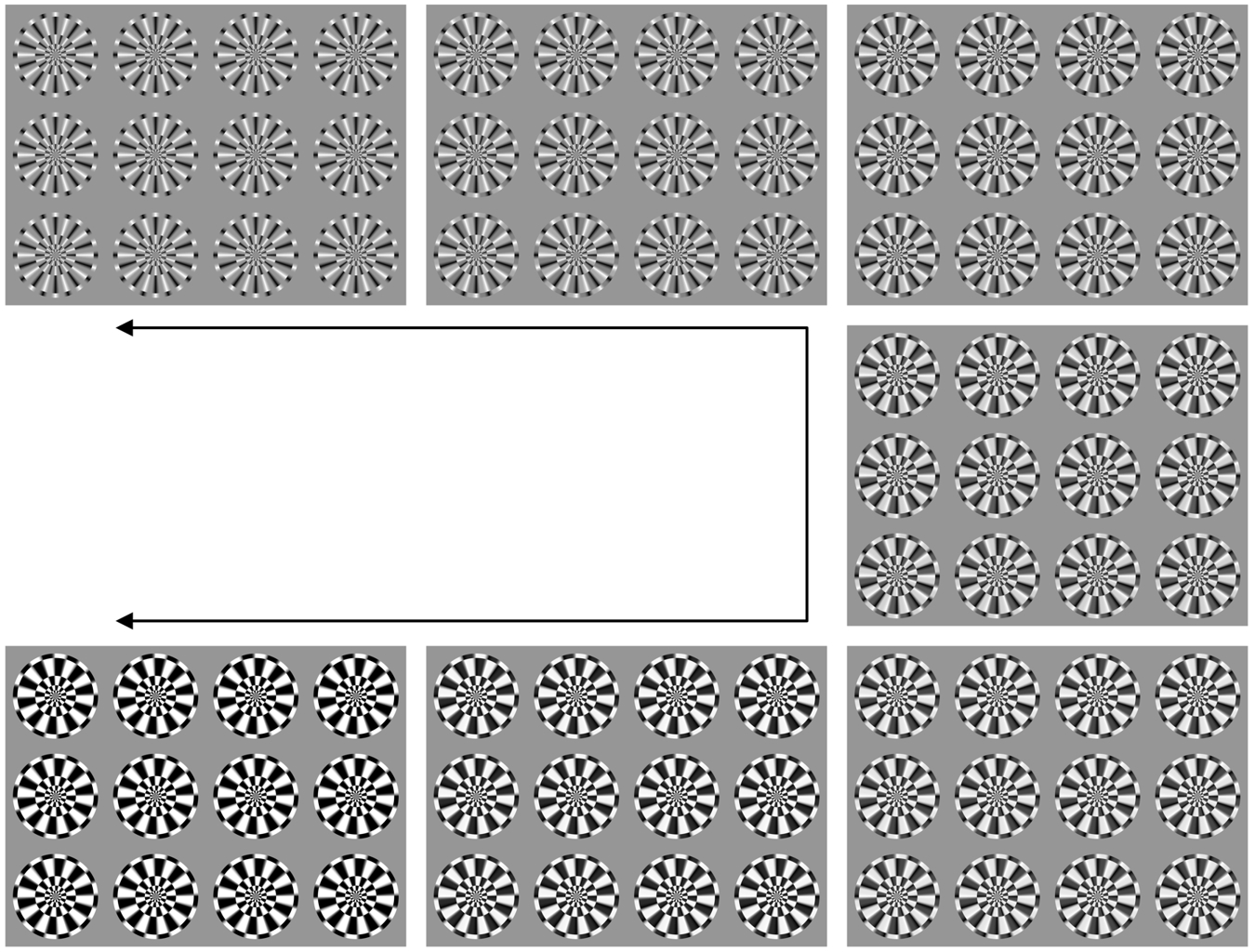
Configurational coincidence among six phenomena: A comment to van Lier
and Csathó (2006)
Kitaoka, A. (2006). Configurational coincidence among six phenomena: A comment on van Lier and Csathó (2006). Perception, 35, 799-806. animations --- PDF
Adobe Flash Player is necessary to play animations on this page.
Animation 1
Reversed phi movement (Anstis and Rogers 1975). There are four rectangles, each of which is flanked by thin lines that are dark or light. When the luminance of the rectangles decreases and that of the background increases accordingly, the upper two appear to converge in motion while the lower two appear to go apart in motion. On the other hand, when the luminance of the rectangles increases and that of the background decreases accordingly, the upper two appear to go apart in motion while the lower two appear to approach each other in motion. In sum, the direction of apparent motion is from the dark flank to the neighboring part that goes darkening or from the light flank to the neighboring part that goes brightening. Although the rectangles are aligned vertically, the apparent positional displacement occurs in the opposite direction to motion. If observers cross-fuse (uncross-fuse) the right and left rectangles, the upper rectangle appears to be in front of (behind) the lower one when they are dark.
Animation 2
The illusory motion investigated by Gregory and Heard (1983). This appearance is quite similar to Animation 1. The only configurational difference from the reversed phi movement is that the luminance of the rectangles is constant.
Animation 3
The illusory motion mentioned by Gregory and Heard (1983), in which the luminance of the rectangles dynamically changes while that of the surround is constant. This appearance is quite similar to Animations 1 and 2.
Animation 4
Phi movement (Anstis and Rogers 1975). For panel (a), dark stationary rectangles are placed on a bright stationary background. When the luminance of the right flank of each rectangle increases and that of the left flank decreases, the rectangle appears to shift leftward in motion as well as in position. Conversely, the luminance of the right flank decreases and that of the left flank increases, the rectangle appears to shift rightward in motion and position. If observers cross-fuse (uncross-fuse) the right and left rectangles, the fused rectangle appears to be in front (behind) when the right flank of the right rectangle are dark and the left flank of the left rectangle are dark. For panel (b), bright rectangles are placed on a dark background. In this case, phenomena are the reversal of panel (a).
(a) (b)
(a) Flash(swf) --- QuickTime(mov)
(b) Flash(swf) --- QuickTime(mov)
Animation 5
Consistency between the reversed phi movement and stereopsis (Anstis and Rogers 1975). In this animation, there are two phases in motion, in which the upper-left and the lower-right rectangles are one eighth phase in advance of the upper-right and the lower-left rectangles. For example, when the luminance of the rectangles increases, the upper-left rectangle appear to go leftward followed by the upper-right one, while the lower-right rectangle appear to go leftward followed by the lower-left one. In this period, the cross-fused (uncross-fused) upper rectangle appears to be in front (behind) as compared with the cross-fused (uncross-fused) lower rectangle.
Animation 6
Consistency between the apparent motion and Café-Wall-like tilt illusions (van Lier and Csathó 2005). According to dynamic changes in luminance gradient, the flanks of the rectangle appears to tilt dynamically. (a) The luminance gradient given to both flanks is dynamically changed while the dark-gray rectangle and the light-gray background are stationary. The dark part of the gradient appears to shift outward in motion and position while the bright part appears to shift inward in motion and position. This distortion agrees with the tilt illusion. (b) The luminance gradient given to the rectangle is dynamically changed while the dark flanks and the gray background are stationary. At the dark part of the gradient, the neighboring part of flanks appears to shift inward in motion and position, while at the bright part of the gradient, the neighboring part of flanks appears to shift outward in motion and position. This distortion agrees with the tilt illusion.
(a) (b)
(a) Flash(swf) --- QuickTime(mov)
(b) Flash(swf) --- QuickTime(mov)
Animation 7
Inconsistency between the apparent motion and Café-Wall-like tilt illusions. According to dynamic changes in homogenous areas, the flanks of the rectangle appears to tilt dynamically. (a) The luminance of the homogeneous rectangle is dynamically changed while the flanks with luminance gradient and the gray background are stationary. The darkening rectangle appears to attract the dark parts of the flanks inward in motion while the brightening rectangles appears to attract the light parts of the flanks inward in motion. This distortion disagrees with the tilt illusion. (b) The luminance of the homogeneous flanks is dynamically changed while the rectangle with luminance gradient and the gray background are stationary. At the dark part of the gradient, brightening flanks appears to shift inward in motion, while at the bright part of the gradient, darkening flanks appears to shift inward in motion. This distortion disagrees with the tilt illusion
(a) (b)
(a) Flash(swf) --- QuickTime(mov)
(b) Flash(swf) --- QuickTime(mov)
Animation 8
Demonstration of the apparent motion in the three elemental spatio-temporal configurations (Figure 6). The behaviors in (a), (b) and (g) are summarized in Figure 6a (off-center line-type configuration); those in (c), (d) and (h) are in Figure 6b (on-center line-type configuration); and those in (e), (f) and (i) are summarized in Figure 6c (edge-type configuration). For further explanations, see the text.
(a) (b)
(a) Flash(swf) --- Quicklime(mov)
(b) Flash(swf) --- QuickTime(mov)
(c) (d)
(c) Flash(swf) --- QuickTime(mov)
(d) Flash(swf) --- QuickTime(mov)
(e) (f)
(e) Flash(swf) --- QuickTime(mov)
(f) Flash(swf) --- QuickTime(mov)
(g) (h) (i)
(g) Flash(swf) --- QuickTime(mov)
(h) Flash(swf) --- QuickTime(mov)
(i) Flash(swf) --- QuickTime(mov)
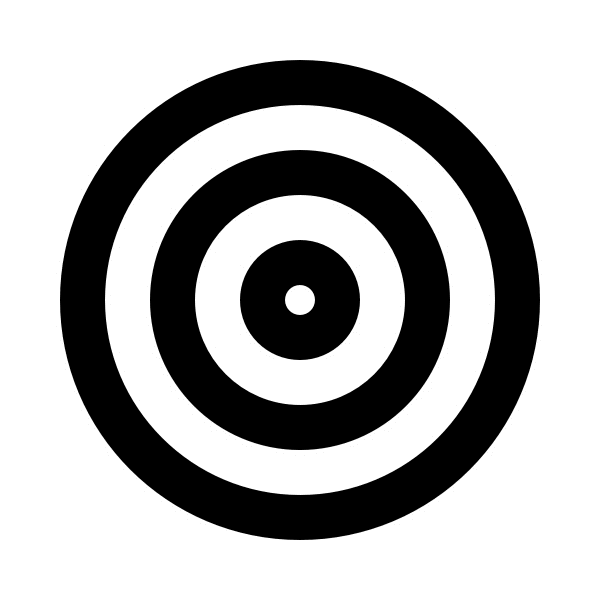
Copyright Akiyoshi Kitaoka 2010 (April 3)
Nice demos
Arthur Shapiro's Illusions and Demonstration
Directions of illusory motion depending on changes of luminance in each
area
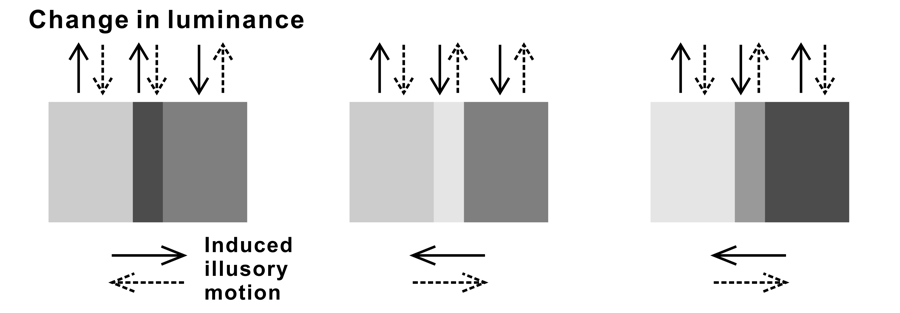

Involvement of the Purkinje shift is suggested. Short wavelength color
appears to be relatively bright under a dark condition. Decreasing illumination
makes short wavelength color relatively bright. This might induce the luminance
change-dependent motion illusion and show the color-dependent Fraser-Wilcox
illusion.
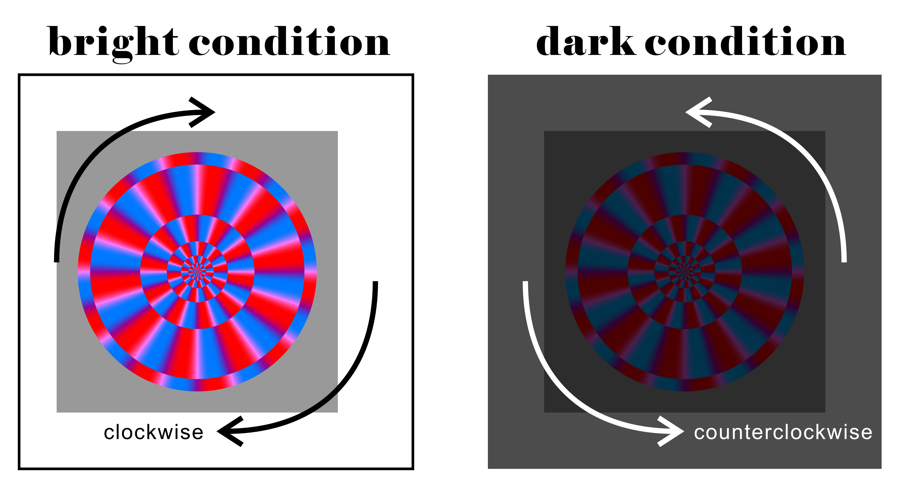
References
Kanazawa, S., Kitaoka, A., and Yamaguchi, M. K. (2013). Infants see illusory motion in static figures. Perception, 42, 828-834.
Ashida, H., Kuriki, I., Murakami, I., Hisakata, R. and Kitaoka, A. (2012). Direction-specific fMRI adaptation reveals the visual cortical network underlying the "Rotating Snakes" illusion. NeuroImage, 61, 1143–1152.
Otero-Millan, J.,Macknik, S. L., and Martinez-Conde, S. (2012). Microsaccades and Blinks Trigger Illusory Rotation in the “Rotating Snakes” Illusion. Journal of Neuroscience, 32, 6043-6051.
Stevanov, J., Marković, S., and Kitaoka, A. (2012). Aesthetic valence of visual illusions. i-Perception, 3(2), 112–140.
Tomimatsu E., Ito, H., Sunaga, S., & Remijn, G. B. (2011). Halt and recovery of illusory motion perception from peripherally viewed static images. Attention, Perception, & Psychophysics, 73, 1823-1832.
Tomimatsu, E., Ito, H., Seno, T., and Sunaga, S. (2010). The ‘rotating snakes’ in smooth motion do not appear to rotate. Perception, 39, 721-724.
Fermüller, C., Ji, H., and Kitaoka, A. (2010). Illusory motion due to causal time filtering. Vision Research, 50, 315–329.
Billino, J., Hamburger, K., & Gegenfurtner, K. R. (2009). Age effects on the perception of motion illusions. Perception, 38, 508-521.
Kuriki, I., Ashida, H., Murakami, I., and Kitaoka, A. (2008). Functional brain imaging of the Rotating Snakes illusion by fMRI. Journal of Vision, 8(10):16, 1-10.
Hisakata, R. and Murakami, I. (2008) The effects of eccentricity and retinal illuminance on the illusory motion seen in a stationary luminance gradient. Vision Research, 49, 1940-1948.
Beer, A. L., Heckel, A. H. and Greenlee, M. W. (2008) A motion illusion reveals mechanisms of perceptual stabilization. PLoS ONE, 3(7): e2741, 1-7. doi:10.1371/journal.pone.0002741
Chi, M-T., Lee, T-Y., Qu, Y., and Wong, T-T. (2008) Self-Animating Images: Illusory Motion Using Repeated Asymmetric Patterns. ACM Transaction on Graphics (Proceedings of SIGGRAPH 2008), 27, No.3.
Murakami, I., Kitaoka, A. and Ashida, H. (2006) A positive correlation between fixation instability and the strength of illusory motion in a static display. Vision Research, 46, 2421-2431.
Conway, R. B., Kitaoka, A., Yazdanbakhsh, A., Pack, C. C., and Livingstone, M. S. (2005) Neural basis for a powerful static motion illusion. Journal of Neuroscience, 25, 5651-5656.
Backus, B. T. and Oruç, I. (2005) Illusory motion from change over time in the response to contrast and luminance. Journal of Vision, 5, 1055-1069.
Kitaoka, A. and Ashida, H. (2003) Phenomenal characteristics of the peripheral drift illusion. VISION (Journal of the Vision Society of Japan), 15, 261-262. PDF
Naor-Raz, G. and Sekuler, R. (2000) Perceptual dimorphism in visual motion from stationary patterns. Perception, 29, 325-335.
Faubert, J. and Herbert, A. M. (1999) The peripheral drift illusion: A motion illusion in the visual periphery. Perception, 28, 617-621.
Fraser, A. and Wilcox, K. J. (1979) Perception of illusory movement. Nature, 281, 565-566.
Parreira Katy, Italy, has uploaded a movie on YouTube on October 10, 2013, which shows that her cat Molly (seven years old) appears to see the "Rotating snakes" illusion. I think this is the second piece of evidence that cats see motion illusion in a static image.
https://www.youtube.com/watch?v=1KrboUI1hg8
References
<Illusion news 16, article on February 28>
Rasmus Bååth, Lund University Cognitive Science, Sweden, shows evidence
that the cat sees the Rotating snakes illusion!
http://youtu.be/CcXXQ6GCUb8
<October 14, 2013>
Q: Is the illusory motion directed from high-contrast regions to low-contrast ones?
A: No.
Kitaoka, A. and Ashida, H. (2004). A new anomalous motion illusion: the
"central drift illusion". The 2004's winter meeting of the Vision Society of Japan at the Kogakuin
University, Shinjuku, Tokyo, Japan, 2004/1/26-28, 1/26 oral publication. Presentation
Central drift illusion
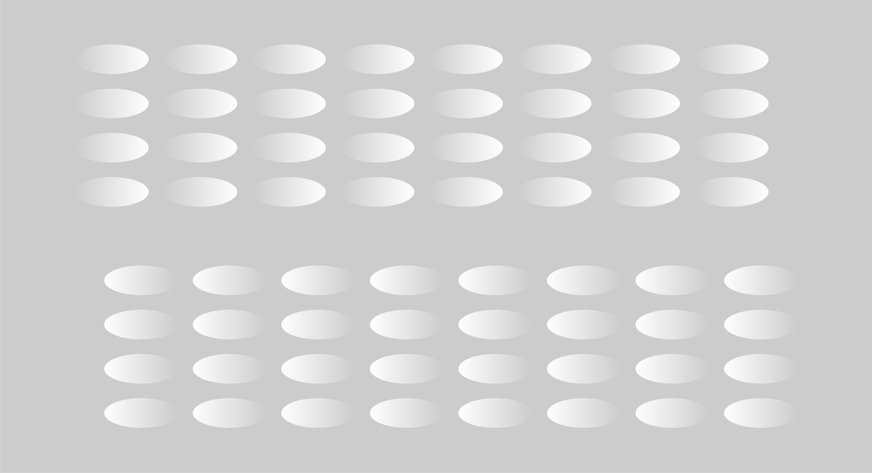
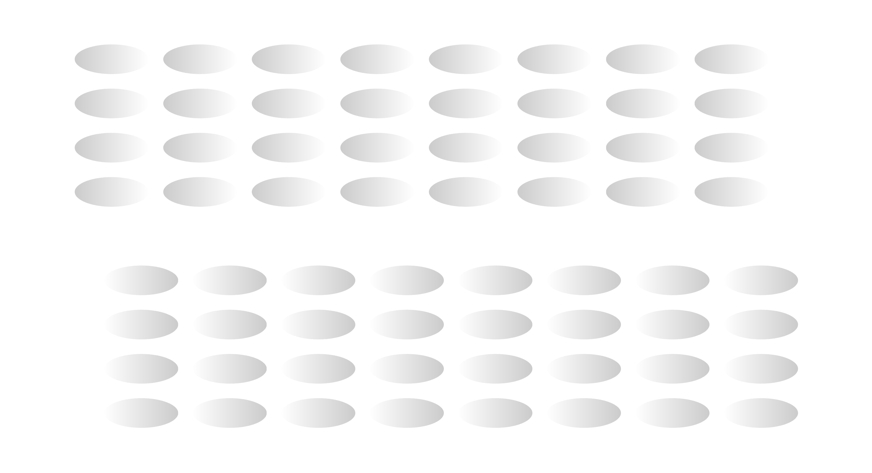
Expansion illusion of visual phantoms due to the central drift illusion
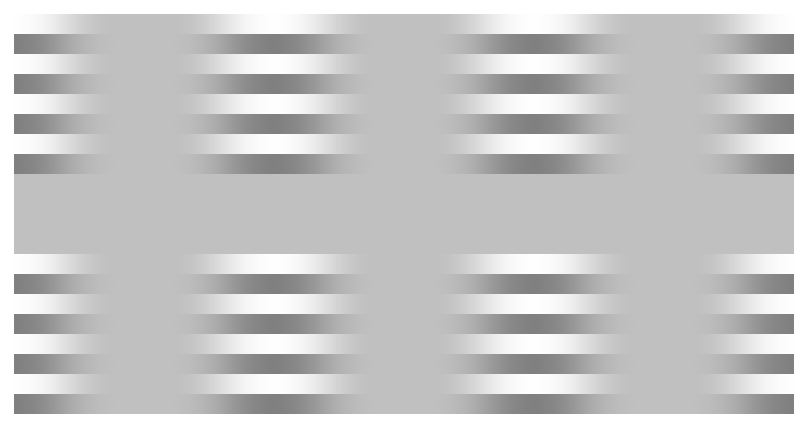
"Introduction to visual illusions"
Prospect
For a variety of visual illusions, I have distinguished sakushi (錯視) from damashie (騙し絵, trompe l'oeil) from the viewpoint of whether it is functional or not. Yet, there is increasing evidence for the involvement of some functional origins in the phenomena called sakushi (錯視).
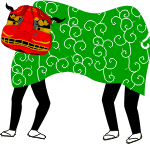 おしまい 終 The end
おしまい 終 The end
Thank you! 谢谢 ご清聴ありがとうございました。


Abstract
Visual illusion refers to a phenomenon that the perception of an object or its properties is different from what it should ‘objectively’ be. There are a variety of visual illusions including the geometrical illusion (shape illusion), color illusion, lightness illusion, motion illusion etc., depending on visual attributes. Mechanisms and functions are fairly understood for some illusions while not for others.
The ‘functional’ illusion should be distinguished from the ‘not-functional’ illusion. To put it simply, the former is called trompe l’oeil or ‘damashie’ in Japanese, while the latter is called ‘sakushi’ in Japanese. For example, the Ames room, a kind of trompe l’oeil, can be understood in terms of competition between shape constancy and size constancy. Both pieces of constancy are functional. On the other hand, the ‘Rotating snakes’ illusion created by Kitaoka in 2003 shows illusory motion in a static image but cannot be accounted for in terms of any function. Actually sakushi is translated to visual illusion or optical illusion, but they are not identical. Moreover, mechanisms of sakushi tend to be less distinct than those of trompe l’oeil.
In this workshop, I will talk about mechanisms and functions of some illusions. One is the spiral illusion, in which concentric circles appear to be spirals. This illusion is explained with cooperation between orientation-selective neurons in V1 and spiral pattern-responding neurons in V4 (Kitaoka et al., 2001). Another is a motion illusion in a static image, in which the inset of low contrast appears to move in the same direction as the image motion that observers make. This illusion is explained in terms of the difference in visual latency between a high-contrast region and a low-contrast one (Kitaoka and Ashida, 2007). The former gives a shorter latency than the latter, giving apparent displacement within the image.
The latest issue I have been studying for a couple of years is the Fraser-Wilcox illusion group. The Fraser-Wilcox illusion was proposed in 1979. However, it was not followed by subsequent research for no less than twenty years because of difficulty of reproduction. This problem was solved by Kitaoka and Ashida (2003) who separated one illusion from another. Since these two illusions cancel each other in the original Fraser-Wilcox illusion image, rearranging them so as to work together makes a strong illusion. I call it the ‘optimized’ Fraser-Wilcox illusion.
At present, there are five types of the ‘optimized’ Fraser-Wilcox illusion, each including two subtypes. Then, ten basic illusions constitute this group. These illusions are strong in the peripheral vision as well as in bright stimuli or in bright illumination. The ‘Rotating snakes’ illusion is a product of this group. In fMRI studies, it was revealed that the ‘Rotating snakes’ illusion image activates hMT+ as well as lower visual areas such as V1 or V2 (Ashida, 2012; Kuriki et al., 2008). Yet the mechanism of this illusion remains indistinct.
Moreover, Kitaoka (2012) proposed a novel variant, in which illusion is strong in dark stimuli. This variant is strong in bright illumination like the previous variants. Furthermore, another novel illusion, which depends on color and is strong in dark illumination, has subsequently been revealed (Kitaoka, 2013). This color-dependent illusion shows a reversal in the direction of illusory motion depending on illumination. Here I will discuss this paradoxical illusion mentioning possible involvement of rod activity..
References
Ashida, H., Kuriki, I., Murakami, I., Hisakata, R. and Kitaoka, A. (2012). Direction-specific fMRI adaptation reveals the visual cortical network underlying the "Rotating Snakes" illusion. NeuroImage, 61, 1143–1152.
Kitaoka, A. (2012). The Fraser-Wilcox illusion and its extension. Perception 41 ECVP Abstract Supplement, page 91.
Kitaoka, A. and Ashida, H. (2003). Phenomenal characteristics of the peripheral drift illusion. VISION (Journal of the Vision Society of Japan), 15, 261-262.
Kitaoka, A. and Ashida, H. (2007). A variant of the anomalous motion illusion based upon contrast and visual latency. Perception, 36, 1019-1035.
Kitaoka, A. and Yanaka, H. (2013). Reversal of the color-dependent Fraser-Wilcox illusion under a dark condition. Perception 42 ECVP Abstract Supplement, page 97.
Kitaoka, A., Pinna, B., and Brelstaff, G. (2001). New variations of spiral illusions. Perception, 30, 637-646.
Kuriki, I., Ashida, H., Murakami, I., and Kitaoka, A. (2008). Functional brain imaging of the Rotating Snakes illusion by fMRI. Journal of Vision, 8(10):16, 1-10.